ARCHIVED - Review of the RCMP's Public Complaint Records
Archived information
Archived information is provided for reference, research or recordkeeping purposes. It is not subject to the Government of Canada Web Standards and has not been altered or updated since it was archived. Please contact us to request a format other than those available.
Table of Contents
Follow-Up of RCMP Response to Review of the Record Report Recommendations
Part One: Quantitative Analysis of Complaint Dispositions
- RCMP-Wide and Regional Analysis
- Disposition of Complaints
- Chronic and Multiple Complainants
- Service Standards: Processing Time
Part Two: Outstanding Disposition List
Appendices
- Common Terminology
- List of Issues
- List of Allegations
- Map of RCMP Divisions
- Public Complaint Process
- Yearly Comparison – At A Glance
- Termination Flowchart
Review of the Record Report: 2007 – Force-Wide and Regional: Updated
Division Reports: 2008
Executive Summary
The Commission for Public Complaints Against the RCMP ("the Commission") performs a vital role in Canadian society in that it provides civilian review of the conduct of RCMP members in carrying out their policing duties thereby holding the RCMP accountable to the public.
To assist in maintaining this strong accountability, and pursuant to paragraph 45.47(b) of the RCMP Act, the Commission created the Review of the Record Project, which was designed to examine all complaint dispositions stemming from public complaints against the RCMP.1 The Commission's examination of the complaint dispositions analyzes trends in the types of allegations made by the public against the RCMP, how the complaint was disposed of by the RCMP and if the disposition was in keeping with RCMP policy, and provides the Commission and the RCMP with an empirical foundation to assess how effectively the overall public complaint system for the RCMP is functioning. This project is only in its second year and already there has been a noticeable increase in the number of records provided to the Commission and an improvement with respect to service standards and interaction between the two organizations.2
The project consists of two major components: the Review of the Record, that assesses all completed complaint dispositions and the Outstanding Disposition List, which tracks all open Commission-lodged complaint files.
The Commission's Review of the RCMP's Public Complaints Records-2007, made six (6) recommendations for immediate implementation; RCMP Headquarters, however, did not respond to this report or its recommendations.3 The Commission is concerned about this lack of response from Headquarters, given that there appears to be issues with the RCMP public complaint process to be rectified, and those identified in last year's report have been further exacerbated by inaction. It should be noted that some divisions did respond to the Commission directly and their responses were insightful and valuable.
The RCMP lacks a comprehensive public complaints database which makes tracking public complaints Force-wide very difficult. The administrative issues apparent in the RCMP's public complaint process are further complicated by a lack of current guidelines with respect to informal resolutions, terminations, and Part IV investigations. As well, manuals related to the public complaint process have not been updated to ensure a standardized national approach.
Simply put, the Professional Standards and External Review Directorate is unable, with certainty, to identify when complaints were lodged, how many have been lodged, where they were lodged, the members involved, what the nature of the complaints are and if an investigation or appropriate disposition has been completed on a national level. Further, the Commission has serious concerns with respect to the administration of the RCMP public complaint process within the Territories (Yukon, Northwest Territories, and Nunavut).
Despite the Commission concerns with the systemic issues apparent in the public complaint system, the results of the 2008 Review of the Record show improvements in regional and divisional service standards and a positive engagement between the divisions and the Commission.
The data collected for this report is for the calendar year 2008 and is based on all completed complaint records4 received by the Commission before July 1, 2009, with a complaint date between January 1, 2008 and December 31, 2008. The Commission received 1,829 completed complaint dispositions relating to complaints lodged within the 2008 timeframe but has been advised by the RCMP that 2,375 complaints5 were lodged in that year; therefore, approximately 23% of 2008 complaints remain outstanding.
Of the 1,829 complaint dispositions, 1,238 were lodged with the Commission (68%) while 584 were lodged with the RCMP (32%). Seven (7) additional complaints were lodged initially with other organizations representing 0.4% of the total complaints.6 With respect to Commission-lodged complaints this represents an 8% increase from 2007; and a 7% decrease for the RCMP.
Figure 1: Percentage of Complaints Lodged with CPC by Division7
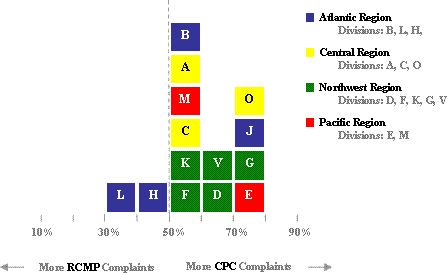
Based on the complaint dispositions received, the Pacific Region8 had the most complaints (814) representing 45% of the total, the Northwest Region had 692 (38%), the Central Region had 64 (3%) and the Atlantic Region had 259 (14%).
A total of 4,511 allegations were made against the RCMP and its members. The most common complaint allegations as identified by the RCMP were "Neglect of Duty" (29%), "Improper Attitude" (22%) and "Improper Use of Force" (10%). As with the allegations in 2007, there is a common perceived lack of police professionalism, although allegations of "Improper Use of Force" are down 3% in 2008. A total of 295 members had two or more complaints lodged against them, which represented 13% of the total number of members named in complaints.
In its handling of complaints, the RCMP issued a Final Report (RCMP) in 43% of the cases, issued a Notice of Direction9 (termination) 6% of the time, entered into an informal resolution in 34% of all cases and accepted a complaint withdrawal in 16% of the cases.
During the analysis of the documents, the Commission noticed that 6% of the total informal resolutions dealt with allegations of "Improper Use of Force" and that 13% of all use of force allegations resulted in an informal resolution. Of those allegations, 59% were deemed by the Commission to have been resolved contrary to policy. "J" Division appeared to have the most informal resolutions of "Improper Use of Force" with 33% of these allegations being resolved in this manner.
The Commission also found that 17% of all withdrawn complaints, contained serious allegations including: "Improper Use of Force", "Improper Use of Firearms", and "Statutory Offences". Withdrawn complaints containing serious allegations accounted for nearly 3% of total complaints dispositions for 2008. It is the position of the Commission that serious allegations, especially incidents involving weapons or injury, should typically not be allowed to be withdrawn, as it undermines the integrity of the public complaint process and is unfair to both members and complainants.
In 2008 the RCMP took, on average, 103 days to issue a disposition once a complaint was lodged and an additional 69 days for the Commission to receive a copy of the disposition.10 It took, on average, 200 days for a complainant to lodge a complaint after the incident of concern. This is an improvement from 2007, when it took the RCMP, on average, 114 days to issue a disposition and an additional 86 days for the Commission to receive a copy.
The Commission is pleased to report that in 2008 the RCMP took, on average, 103 days to issue a disposition once a complaint was lodged. This is an eleven (11)-day reduction in processing time from 114 days in 2007. Interestingly, on average, 20011 days elapsed before a complainant lodged a complaint after the incident of concern, on average; this is down from an average of 229 days in 2007.
The second aspect of this project is the production and management of the Outstanding Disposition List, which is designed to act as an accounting mechanism for all Commission-lodged complaints that are at any given time being investigated by the RCMP. Information gathered through the Outstanding Disposition List allows the Commission to track how timely the RCMP is responding to complaints and to identify the length of time complaints are taking to be investigated. Commendably, the RCMP reduced the number of pre-2007 outstanding complaints by an additional 68% from 2007, with only 48 dispositions still outstanding from that timeframe.
The Commission's undertaking of following up with the RCMP with questions raised in the analysis of complaint dispositions has also proved successful, with an RCMP turnaround time from request to response of 33 days. There were 62 follow-up requests made; of those, the Commission's concerns and requests were met in 87% of the cases. It must be noted that under the current legislation the Commission does not have the authority to direct the RCMP to investigate a complaint. Accordingly, while the RCMP may choose to refuse the Commission's request to investigate even when it involves serious allegations such as improper use of force or when injuries have allegedly been sustained,12 this practice is contrary to RCMP policy. Moreover, the Commission does retain the authority pursuant to the RCMP Act to launch a Chair-initiated complaint and/or public interest investigation into such a matter if the RCMP refuses to properly investigate the complaint in the first instance.
The Commission has taken a proactive approach with respect to what information should be contained in the four different types of complaint dispositions. A "Best Practices" section has been added to the Commission's website to assist those who are tasked with the responsibility of writing complaint dispositions. Further, a position paper on the appropriate application of the termination paragraphs has also been prepared.
The Commission has also undertaken new information-tracking practices as a result of difficulties stemming from issues that arise from the quality of complaint dispositions. The Commission has noted that for informal resolutions, it is not uncommon for the member to be informed of the complaint after the complaint had been resolved. Without member participation in the informal resolution process, the Commission is concerned that the principle underlying informal resolutions is undermined. As such, the Commission has begun recording the member informed date, as recorded on Form 4110, with the intention of conducting future analysis. As well, the Commission has also begun to track the dates that dispositions are received by the Divisional Professional Standards Offices as well as the Professional Standards and External Review Directorate at RCMP Headquarters. Although it is hoped that this will aid the Commission in tracking timeliness of service, the information is not readily available for many of the documents received.
The Commission continues to find these projects valuable in that they have increased cooperation between the Commission and the RCMP; have assisted in reducing the large number of outstanding complaint dispositions; and through quantitative and qualitative analyses have identified trends that can be utilized to improve the quality of, and enhance public confidence in, the overall public complaint system.
Follow-Up of RCMP Response to Review of the Record Report Recommendations
The Commission's Review of the RCMP's Public Complaints Records-2007, made six (6) recommendations for immediate implementation. Unfortunately, the RCMP did not officially respond to the 2007 report, nor did it respond to the recommendations. The Commission is concerned about this lack of response, given that there are concerns with the RCMP public complaint process that need to be rectified.
Some RCMP divisions, however, did respond directly to the Commission as well as to their contracting province. Their responses provided a greater understanding of what steps these divisions were going to take to effectively address the areas identified as needing improvement; allowed them to highlight changes they had made; underscored the positive work they had been engaged in with various stakeholders; as well as raised questions about some of the Commissions findings. Many of the suggestions provided by these divisions with respect to the Review of the RCMP's Public Complaints Records-2007 have been incorporated into this report. It is hoped in the future that other divisions, as well as theProfessional Standards and External Review Directorate at RCMP Headquarters, will provide feedback to the Commission.
Although there was no official response from the RCMP, the Commission is in a position to detail what general steps have been taken by the Force in relation to the RCMP public complaint process and further expand on our concerns. It should be stressed that the RCMP and the Commission have recently engaged in dialogue to address many of these issues. These recommendations were:
1. That the Professional Standards and External Review Directorate at RCMP Headquarters organize a Force-wide meeting of divisional Professional Standards units and the Commission in order to discuss best practices and ways of improving efficiency and effectiveness in the public complaint process.
The Commission has been advised that the Professional Standards and External Review Directorate at RCMP Headquarters was planning such a meeting scheduled for the fall of 2009. Some divisions and regions already hold such meetings on a regular basis and have invited the Commission to participate. For instance, a presentation by the Commission on key issues was made to the "E" Division Professional Standards and External Review Directorate in January 2009. This has served to further solidify the working relationship between the RCMP and the Commission and to assist in standardizing the public complaint process which assists both organizations in improving service to Canadians.
2. That the Professional Standards and External Review Directorate at RCMP Headquarters send out a directive clearly articulating:
- when it is appropriate to informally resolve improper use of force complaints and when it is not;
- how public complaints defined under Part VII of the RCMP Act are to be processed when the complainant raises statutory offence allegations; and
- when it is appropriate to terminate a public complaint under the RCMP Act and what information must be included in a Notice of Direction.
Unfortunately, neither this recommendation nor its subcomponents has been met. Given this lack of response and the need for clarification, the Commission compiled, from RCMP documents, criteria that should be met while completing complaint dispositions. As well, the Commission has also authored a position paper on the appropriate application of the termination provisions in the RCMP Act and what information must be included in the Notice of Direction.13 Both of the criteria and the termination position paper are available on the Commission's website.
3. That the RCMP implement a more efficient means of tracking public complaints and that divisions and detachments provide the Commission with a copy of all of the outstanding complaint dispositions.
The recommendation has not fully been met. The divisions and detachments throughout the Force have been providing the Commission with dispositions and have worked diligently in addressing the outstanding dispositions that need to be provided to the Commission. This cooperation is commendable and the evidence of this hard work is further detailed in the Outstanding Disposition List section of the report.
Notwithstanding this, the Professional Standards and External Review Directorate at RCMP Headquarters has not implemented an efficient means of tracking public complaints. In an attempt to address this, in January 2009, the Commission provided the RCMP with a blank copy of the Review of the Record database and offered technical assistance with respect to its use. This was done in an effort to assist the RCMP in upgrading its case tracking system and to facilitate a more efficient (and standardized) approach to processing the thousands of complaints that are submitted each year. At the time of writing this report the Professional Standards and External Review Directorate had not implemented the database and indicated to the Commission that despite it being provided to the Force nine months prior, it was still under "assessment" from a Privacy Act standpoint.
The lack of a comprehensive database is problematic for a number of reasons, as record-keeping associated with the Force-wide public complaints system is inconsistent, ineffective and disorganized. There is no centralized tracking mechanism, complaints from across the entire Force are tracked on an Excel spreadsheet, sometimes without file numbers or the full names of the complainants, and there is limited search capability. This is especially challenging when there are complainants who submit multiple complaints or when there are unrelated complainants who have the same last name.
To further complicate matters, the RCMP spreadsheet does not capture when a complaint was lodged, only when the Professional Standards and External Review Directorate was notified of the complaint, which makes it difficult to properly track the life of a complaint or to properly assess how long a complaint has been outstanding. The Commission does capture this information and provides the Professional Standards and External Review Directorate at RCMP Headquarters with an outstanding disposition list approximately every three months for distribution to the divisions.
Unfortunately, the RCMP list is not adequately maintained or regularly updated and attempts by the Commission to reconcile our lists with those of the Force resulted in our organization being provided with hundreds of duplicate complaint records; the identification of open complaints that had, in reality, been closed; the identification of complaints that had been closed but were, in actual fact, still under investigation; and the identification of complaints that were not known to the Professional Standards and External Review Directorate. Simply put, the Professional Standards and External Review Directorate is unable, with certainty, to identify when complaints were lodged, how many have been lodged, where they were lodged, the members involved, what the nature of the complaints are, and if an investigation or appropriate disposition has been completed on a national level.
While the record keeping of public complaints may be considered an internal administrative matter within the RCMP, the present problems associated with the tracking and documenting of the public complaint system is such that it negatively impacts the functioning and effectiveness of RCMP oversight.
The Commission, therefore, recommends that the RCMP implement a proper public complaint database immediately to ensure efficiency in the system. Since the Professional Standards and External Review Directorate has centralized aspects of the public complaint system by requesting divisions to provide it with copies of complaint forms and dispositions (before they are provided to the Commission) it is essential that it has the technical infrastructure and resource capacity in place to facilitate this.
4. That the RCMP ensure that those tasked with capturing public complaints and writing complaint dispositions be appropriately trained and that manuals related to the public complaint process be immediately updated to ensure a standardized national approach.
The Commission has been aware for some time of the intention of the Professional Standards and External Review Directorate to update the manuals and guidelines associated with public complaints and internal investigations. To date, this has not been completed. Guidance and standardization at the national level is needed and therefore, the Commission reiterates its recommendation that this training be completed in a more timely fashion.
5. That the RCMP commit to improving its service standards by implementing ways to reduce wait times and increase processing times for complaint dispositions.
This recommendation has not yet been met. However, the Commission notes, with encouragement, that the findings of the 2008 Review of the Record Report indicate a considerable improvement in timelines over those indentified in the Report for 2007. This reflects the hard work and commitment of the divisions in strengthening the public complaint process.
6. That the RCMP ensure that all of the complaint dispositions be provided to the Commission concurrent to being provided to the member and the complainant.
This recommendation has not been met, as the Professional Standards and External Review Directorate at RCMP Headquarters has taken steps to centralize the process and insists that all complaint dispositions be provided to it before they are provided to the Commission. While the rationale behind this decision is understandable, given the current concerns with record keeping the Commission is concerned that this aspect of the centralization will negatively impact service to Canadians and the strict service standards which the Commission has imposed upon itself. To that end, the Commission will review the impact of this centralization on the timeliness of Professional Standards and External Review Directorate service delivery and if the negative impact persists, then will recommend that the decision to centralize be reversed.
Given the Commission's concerns with respect to record keeping and data collection of Professional Standards and External Review Directorate at RCMP Headquarters, the Commission is of the opinion that it cannot rely on any statistics, or accountability reports that are released by this Directorate until the latter corrects the deficiencies identified in its record keeping practices. The Commission does note that this Directorate has appointed a new manager of the Public Complaint Unit. This additional resource will hopefully assist with the workload demands on this section.
Recommendations
Recognizing the importance of RCMP-wide consistency and based on the findings of the analyses within the Review of the Record Project, the Commission recommends to the Commissioner of the RCMP the following:
- That the RCMP immediately implement the recommendations made by the Commission in its Review of the RCMP's Public Complaints Records-2007 report.
- That the Professional Standards and External Review Directorate at RCMP Headquarters immediately implement a proper database to track public complaints and related processes so that this Directorate will be able, at a minimum, to identify when complaints were lodged, how many have been lodged, where they were lodged, the members involved, what the nature of the complaints are and if an investigation or appropriate disposition has been completed on a national level.
- That the RCMP ensure that those tasked with capturing public complaints and writing complaint dispositions receive complete and ongoing training and that manuals related to the public complaint process be immediately updated to ensure a standardized national approach.
- That the RCMP commit to improving its service standards by implementing ways to reduce wait times and reduce processing times for complaint dispositions.
- That the Professional Standards and External Review Directorate at RCMP Headquarters immediately issue a directive to RCMP members clearly articulating:
- What constitutes "serious allegations" and when it is appropriate to informally resolve improper use of force complaints and when it is not;
- how public complaints defined under Part VII of the RCMP Act are to be processed when the complainant raises statutory offence allegations; and
- when it is appropriate to terminate a public complaint under the RCMP Act and what information must be included in a Notice of Direction.
- That the RCMP amend its policies (as required) regarding the withdrawal of complaints to ensure that its policies clearly articulate when it is appropriate to accept a purported withdrawal of a complaint making "serious allegations"; and that the reasons for the withdrawal are clearly documented on the withdrawal forms.
- That the Commissioner of the RCMP, to enhance consistency and adherence to policy, revise his delegated authority with respect to the issuance of Notices of Direction for terminations from the unit level to, at least, the level of officer (or non-commissioned officer) in charge of the Divisional Professional Standards units.
- That the RCMP implement a national program whereby multiple complaints will be utilized as an "early warning" of potential conduct-related concerns with individual RCMP members.
- That the RCMP commit to initiate a detailed examination into the entire RCMP public complaint process in the Territories. The Commission is amenable to working jointly with the RCMP with respect to this recommendation.
Part One: Quantitative Analysis of Complaint Disposition
RCMP-Wide and Regional Analysis
Since the Commission is unable to precisely account for how many complaint dispositions14 the RCMP has issued at any given moment, or how many complaints have been lodged in total, the Commission must rely on the RCMP to provide the complaint dispositions in a timely fashion in order for the database to be as complete as possible. Given the nature of the public complaint system and the time involved with investigations, the Commission will likely continue to receive complaint dispositions for complaints lodged in 2008 well into 2009, and 2010. This report only analyzes public complaints for which the RCMP has made a decision: a completed complaint disposition.
Further, some of the raw numbers are very small due to the limited number of complaint dispositions submitted by some divisions. Due to this small population size, the ability of the Commission to draw conclusions or provide more fulsome analyses is limited.
Due to these above-mentioned factors, the data included in this report cannot, and does not, reflect all complaints lodged by the public, or complaints investigated by the RCMP, in 2008.
Received Complaints
The data collected for 2008 is based on all completed complaint records received before July 1, 2009,15 with a complaint date between January 1, 2008 and December 31, 2008.16 The Commission received 1,829 completed complaint dispositions relating to complaints lodged within the 2008 timeframe but has been advised by the RCMP that 2,375 complaints17 were lodged in that year; therefore, approximately 23% of 2008 complaints remained outstanding at the time this report was written.
The Pacific Region18 had the most complaints (814) representing 45% of the total, while the Northwest Region19 had 692 (38%); the Central Region20 had 64 (3%); and the Atlantic Region21 had 259 (14%). Although the number of completed complaints received by the Commission increased in 2008; the distribution throughout the Regions remained consistent from the previous year.
Figure 2: Number of Complaints by Region
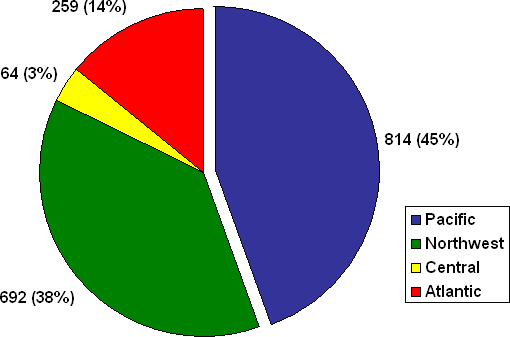
Of those complaints, 1,238 were lodged with the Commission (68%) while 583 were lodged with the RCMP (32%).22 With respect to Commission-lodged complaints this represents an 8% increase from 2007; and a 7% decrease for the RCMP.
Figure 3: Number of Complaints Based on the Organizations it Was Lodged With
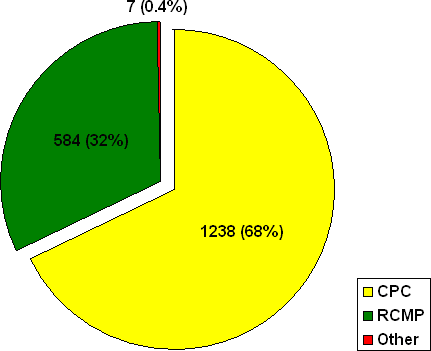
From a regional perspective, complainants in the Pacific Region appeared to favour lodging complaints with the Commission (77%), while complaints lodged with the RCMP accounted for only 23%. This is an 11% increase from 200723 in favour of the Commission. This breakdown could be attributed to the increased presence of the Commission in this region, as the national complaint intake office is located in Surrey, BC.
In the Northwest Region, 60% of the total complaints were lodged with the Commission, 39% were lodged with the RCMP, and 1% was lodged with other organizations.24 In 2007, 59% of the complaints were lodged with the Commission, 40% were lodged with the RCMP and 1% was lodged with the FSIN.25
In the Central region, 61% of the total complaints were lodged with the Commission, while 39% of complaints were lodged with the RCMP. As with the Atlantic Region, there is a change in the statistics related to where complainants lodged their complaints; numbers in 2007 were evenly spilt between the two organizations.
In the Atlantic Region, 60% of the total complaints were lodged with the Commission, while 40% of the total were lodged with the RCMP. This is an increase from the 2007 complaints where there was an even split between the two organizations.
Figure 4: Regional Breakdown: Number of Complaints Based on the Organization it Was Lodged With
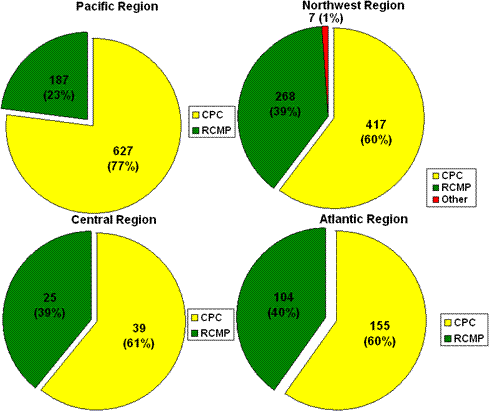
Occasionally, the Commission received a complaint against a whole detachment. In 2008, the Commission received 102 of these; the region most likely to have complaints against a whole detachment was the Pacific Region, which represented 6% of its total complaints. A further eleven (11) separate complaints were against the RCMP in general.
The average number of members named in a complaint was 1.5. Given that most front-line policing within the RCMP is done by constables and corporals, it is not surprising that constables were represented in 74% of the total complaints. The rank of corporal was represented in 12% of the public complaints and sergeants were represented in 6% of the complaints. There was little statistical difference between the figures in 2007 and 2008.
Allegations26
A total of 4,511 allegations, an increase from 3,104 in 2007, were made against the RCMP and its members, which averaged approximately 2.5 allegations per complaint. The most common complaint allegations as identified by the RCMP were "Neglect of Duty" (29%), "Improper Attitude" (22%) and "Improper Use of Force" (10%).
Figure 5: Allegations Breakdown Force-Wide
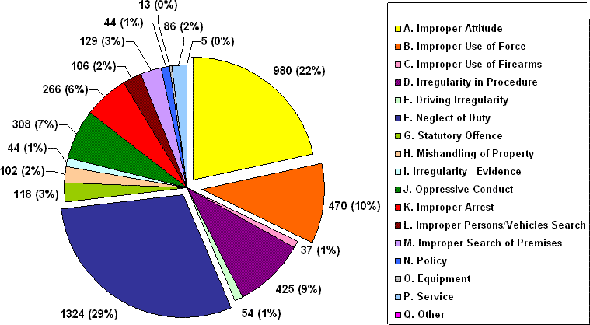
The three most common complaint allegations identified by the RCMP in the Pacific Region were "Neglect of Duty" (30%), "Improper Attitude" (22%) and "Improper Use of Force" (12%).
In the Northwest Region, the three most common complaint allegations were "Neglect of Duty" (29%), "Improper Attitude" (21%) and "Irregularity in Procedure" (11%).
In the Central Region the most common allegations were "Neglect of Duty" (25%), "Improper Attitude" (24%), and "Oppressive Conduct" (22%).
In the Atlantic Region the most common allegations were "Neglect of Duty" (29%), "Improper Attitude" (22%), and "Irregularity in Procedure" and "Oppressive Conduct" at 12% each.
Table 1: Allegations Breakdown by Region
| Pacific | Northwest | Central | Atlantic | Total | ||||||
|---|---|---|---|---|---|---|---|---|---|---|
| Allegation | n | % | n | % | n | % | n | % | n | % |
| A. Improper Attitude | 441 | 22% | 359 | 21% | 30 | 24% | 150 | 22% | 980 | 22% |
| B. Improper Use of Force | 227 | 12% | 186 | 11% | 0 | 0% | 57 | 8% | 470 | 10% |
| C. Improper Use of Firearms | 20 | 1% | 16 | 1% | 0 | 0% | 1 | 0% | 37 | 1% |
| D. Irregularity in Procedure | 138 | 7% | 189 | 11% | 16 | 13% | 82 | 12% | 425 | 9% |
| E. Driving Irregularity | 23 | 1% | 21 | 1% | 4 | 3% | 6 | 1% | 54 | 1% |
| F. Neglect of Duty | 591 | 30% | 503 | 29% | 31 | 25% | 199 | 29% | 1,324 | 29% |
| G. Statutory Offence | 12 | 1% | 96 | 6% | 3 | 2% | 7 | 1% | 118 | 3% |
| H. Mishandling of Property | 49 | 2% | 45 | 3% | 1 | 1% | 7 | 1% | 102 | 2% |
| I. Irregularity – Evidence | 17 | 1% | 19 | 1% | 0 | 0% | 8 | 1% | 44 | 1% |
| J. Oppressive Conduct | 120 | 6% | 78 | 4% | 28 | 22% | 82 | 12% | 308 | 7% |
| K. Improper Arrest | 134 | 7% | 95 | 5% | 5 | 4% | 32 | 5% | 266 | 6% |
| L. Improper Persons/Vehicles Search | 62 | 3% | 31 | 2% | 1 | 1% | 12 | 2% | 106 | 2% |
| M. Improper Search of Premises | 74 | 4% | 42 | 2% | 2 | 2% | 11 | 2% | 129 | 3% |
| N. Policy | 24 | 1% | 19 | 1% | 0 | 0% | 1 | 0% | 44 | 1% |
| O. Equipment | 4 | 0% | 6 | 0% | 2 | 2% | 1 | 0% | 13 | 0% |
| P. Service | 29 | 1% | 35 | 2% | 2 | 2% | 20 | 3% | 86 | 2% |
| Q. Other | 3 | 0% | 1 | 0% | 1 | 1% | 0 | 0% | 5 | 0% |
| Total | 1,968 | 1,741 | 126 | 676 | 4,511 | |||||
The categorization of allegations can further be broken down into those complaints lodged with the Commission and those lodged with the RCMP. The allegations lodged with the Commission represent 72% of total allegations and those lodged with the RCMP represent 28%. This is in comparison to 2007 when allegations lodged with the Commission accounted for 64% and those lodged with the RCMP represented 36%.27
Table 2: Allegations Breakdown by Where Complaints Were Lodged
| CPC | RCMP | FSIN | Alberta Solicitor General | Total | |||||
|---|---|---|---|---|---|---|---|---|---|
| Allegations | N | % | N | % | N | % | N | % | N |
| A. Improper Attitude | 637 | 65.0% | 342 | 34.9% | 0 | 0.0% | 1 | 0.1% | 979 |
| B. Improper Use of Force | 262 | 55.7% | 203 | 43.2% | 4 | 0.9% | 1 | 0.2% | 469 |
| C. Improper Use of Firearms | 26 | 70.3% | 11 | 29.7% | 0 | 0.0% | 0 | 0.0% | 37 |
| D. Irregularity in Procedure | 321 | 75.5% | 102 | 24.0% | 0 | 0.0% | 2 | 0.5% | 423 |
| E. Driving Irregularity | 31 | 57.4% | 23 | 42.6% | 0 | 0.0% | 0 | 0.0% | 54 |
| F. Neglect of Duty | 1,092 | 82.5% | 227 | 17.1% | 3 | 0.2% | 2 | 0.2% | 1,322 |
| G. Statutory Offence | 57 | 48.3% | 60 | 50.8% | 0 | 0.0% | 1 | 0.8% | 117 |
| H. Mishandling of Property | 78 | 76.5% | 24 | 23.5% | 0 | 0.0% | 0 | 0.0% | 102 |
| I. Irregularity – Evidence | 38 | 86.4% | 6 | 13.6% | 0 | 0.0% | 0 | 0.0% | 44 |
| J. Oppressive Conduct | 214 | 69.5% | 94 | 30.5% | 0 | 0.0% | 0 | 0.0% | 308 |
| K. Improper Arrest | 179 | 67.3% | 87 | 32.7% | 0 | 0.0% | 0 | 0.0% | 266 |
| L. Improper Persons/Vehicles Search | 86 | 81.1% | 20 | 18.9% | 0 | 0.0% | 0 | 0.0% | 106 |
| M. Improper Search of Premises | 110 | 85.3% | 19 | 14.7% | 0 | 0.0% | 0 | 0.0% | 129 |
| N. Policy | 40 | 90.9% | 4 | 9.1% | 0 | 0.0% | 0 | 0.0% | 44 |
| O. Equipment | 7 | 53.8% | 6 | 46.2% | 0 | 0.0% | 0 | 0.0% | 13 |
| P. Service | 65 | 75.6% | 21 | 24.4% | 0 | 0.0% | 0 | 0.0% | 86 |
| Q. Other | 5 | 100.0% | 0 | 0.0% | 0 | 0.0% | 0 | 0.0% | 5 |
| Total | 3,248 | 1,249 | 7 | 7 | 4,504 | ||||
| Percentage of Total | 72.1% | 27.7% | 0.2% | 0.2% | |||||
Unlike 2007 where allegations of "Driving Irregularity", "Equipment", and "Improper Persons/Vehicles Search" were most likely to be lodged with the RCMP, in 2008, with the exception of "Statutory Offences" allegations (51%), all other allegation types were most likely to be lodged with the Commission. Further, nine (9) of the seventeen allegation types had allegations made to the Commission, 75% or more of the time. These are: "Irregularity in Procedure" (75%); "Neglect of Duty" (83%); "Mishandling of Property" (76%); "Irregularity-Evidence" (86%); "Improper Persons/Vehicles Search" (81%); "Improper Search of Premises" (85%); "Policy" (91%); "Service" (76%); and "Other" (100%).
Figure 6 & 7: Allegations Breakdown for CPC-Lodge Complaints and RCMP-lodged complaints
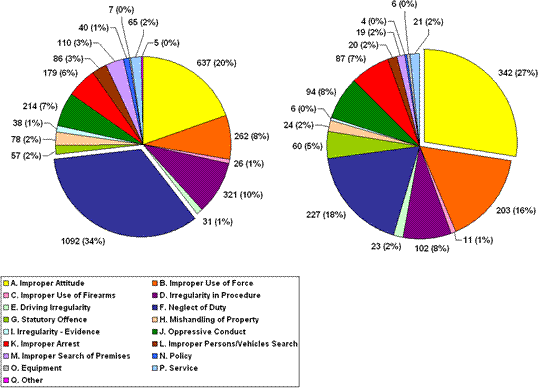
For every complaint disposition received, the Commission analyzed the reason and incident details in order to identify issues related to the nature of the complaint.28 The most common issues that were raised in the complaints were "Attitude"29 (16%), "Service" (12%), "Criminal Investigation Quality" (9%), "Vehicular Incidents" (8%) and issues with "Arrest" (8%). There was no statistically significant difference between the figures from 2007 to 2008, as the types of issues raised in the dispositions appear to be consistent from one year to the next.
Disposition of Complaints30
Once the RCMP has received a complaint, there are four ways that a complaint can be resolved: A complaint can be investigated and a Final Report issued; the complainant can agree to an informal resolution; the complainant can request to withdraw the complaint; or the complaint can be terminated under limited provisions identified in the RCMP Act.
In its handling of complaints, the RCMP issued a Final Report (RCMP) in 43% of the cases, entered into an informal resolution in 34% of all cases, issued a Notice of Direction (termination) 6% of the time, and accepted a complaint withdrawal in 16% of the cases.
Interestingly, in the previous year (2007), the RCMP issued a Final Report in 46% of the cases; issued a Notice of Direction (termination) in 11% of the cases; entered into an informal resolution 30% of the time and accepted a complaint withdrawal in 13% of the cases.
Figure 8: Number of Complaints by Disposition Type: Force-Wide
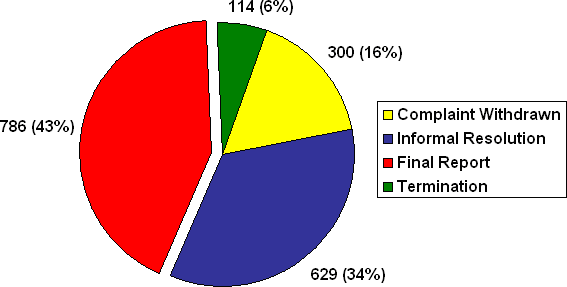
The regional breakdowns for complaint dispositions are as follows:
Figure 9: Regional Breakdown – Number of Complaints by Disposition Type
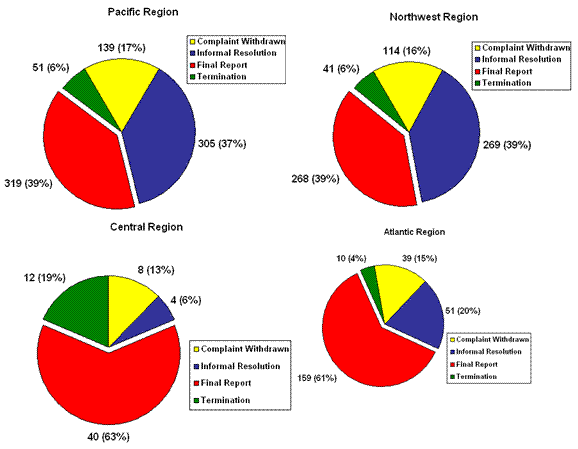
Investigation and Final Report
Of the complaint dispositions the Commission received, 785 were formally investigated and a Final Report31 was issued, representing 43% of the total dispositions. These reports made determinations on 2,412 allegations, with allegations of "Statutory Offence", "Improper Use of Force", and "Improper Arrest" most likely to be disposed of in this manner.
However, when looking at the allegations that were investigated across the country, only 10% were found supported by the RCMP. For the allegation categories that were most likely to be disposed of through a Final Report by the RCMP, the RCMP did not support the allegation between 91% and 98% of the time.32 It is of note that among the allegations that are most likely to be unsupported by the RCMP were "Improper Use of Force" (98% unsupported) and "Oppressive Conduct" (96% unsupported). With respect to serious allegations ("Improper Use of Force", Improper Use of a Firearm" and "Statutory Offence") the RCMP supported 12 of the 406 allegations made or 2.9% of these kinds of allegations. The allegations that were most likely to be supported related to "Service" (45% supported) and "Improper Attitude" (15% supported).
From a regional perspective, the Pacific Region issued a Final Report in 39% of the cases, a decrease from 41% in 2007 and also marginally below the Force average. Of the 942 allegations made, the ones most likely to be disposed of in this manner were "Improper Search of Premises" and "Improper Use of Force". However, when looking at the allegations that were supported and unsupported, it was discovered that only 8% of the total 925 allegations were supported. These supported allegations were most likely to be related to "Improper Attitude" (14% supported) and "Neglect of Duty" (10% supported); while allegations relating to "Improper Use of Firearms" (100% unsupported), "Driving Irregularity" (100% unsupported), "Mishandling of Property" (100% unsupported), and "Improper Use of Force" (99% unsupported) were most likely to be unsupported.
The Northwest Region issued a Final Report in 39% of the cases, which is a decrease from 44% in 2007 and marginally below the Force-wide average. Of the 898 allegations, the ones most likely to be disposed of through a Final Report were "Statutory Offence" and "Improper Persons/Vehicles Search." However, when looking at the allegations that were supported and unsupported, it was found that 13% of the total 879 allegations were supported. These supported allegations were most likely to be related to "Service" (55% supported), "Driving Irregularity" (31% supported), and "Improper Attitude" (18% supported); while allegations relating to "Improper Persons/Vehicles Search" (100% unsupported), "Improper Search of Premises" (100% unsupported), "Irregularity in Evidence" (100% unsupported), and "Improper Use of Force" (97% unsupported) were most likely to be unsupported.
The Central Region issued a Final Report in 63% of the cases, well above the Force-wide average. This is only a slight decrease from 64% in 2007. These Final Reports addressed 85 allegations with "Oppressive Conduct" and "Irregularity in Procedure" most likely to be disposed on in this manner. However, in comparing the allegations that were supported and unsupported, it was found that only 7% of these 82 allegations were supported. These supported allegations were most likely to be related to "Improper Attitude" (18% supported); while allegations relating to "Oppressive Conduct" were most likely to be unsupported (100%).
The Atlantic Region issued a Final Report in 61% of the cases, which is also well above the Force-wide average. This is an increase from 58% in 2007. Of the 487 allegations, the ones most likely to be disposed of through a Final Report were "Improper Persons/Vehicles Search", "Improper Search of Premises", "Neglect of Duty" and "Oppressive Conduct". However, when looking at the allegations that were supported and unsupported, it was found that only 9% of the total 473 allegations were supported. These supported allegations were most likely to be related to "Improper Search of Premises" (67% supported), and "Service" (40% supported); while allegations relating to "Improper Persons/Vehicles Search" (100% unsupported), "Oppressive Conduct" (98% unsupported), and "Improper Use of Force" (98% unsupported) were most likely to be unsupported.
Table3: Allegations Breakdown for Final Reports33
| Pacific | Northwest | Central | Atlantic | Total | ||||||
|---|---|---|---|---|---|---|---|---|---|---|
| n | % | n | % | n | % | n | % | n | % | |
| A. Improper Attitude | 170 | 18% | 138 | 15% | 17 | 20% | 94 | 19% | 419 | 17% |
| B. Improper Use of Force | 146 | 15% | 117 | 13% | 0 | 0% | 40 | 8% | 303 | 13% |
| C. Improper Use of Firearms | 11 | 1% | 9 | 1% | 0 | 0% | 1 | 0% | 21 | 1% |
| D. Irregularity in Procedure | 79 | 8% | 101 | 11% | 12 | 14% | 55 | 11% | 247 | 10% |
| E. Driving Irregularity | 11 | 1% | 13 | 1% | 3 | 4% | 5 | 1% | 32 | 1% |
| F. Neglect of Duty | 281 | 30% | 266 | 30% | 20 | 24% | 156 | 32% | 723 | 30% |
| G. Statutory Offence | 6 | 1% | 82 | 9% | 0 | 0% | 6 | 1% | 94 | 4% |
| H. Mishandling of Property | 20 | 2% | 19 | 2% | 1 | 1% | 3 | 1% | 43 | 2% |
| I. Irregularity – Evidence | 5 | 1% | 12 | 1% | 0 | 0% | 4 | 1% | 21 | 1% |
| J. Oppressive Conduct | 47 | 5% | 29 | 3% | 21 | 25% | 63 | 13% | 160 | 7% |
| K. Improper Arrest | 81 | 9% | 56 | 6% | 5 | 6% | 23 | 5% | 165 | 7% |
| L. Improper Persons/Vehicles Search | 22 | 2% | 20 | 2% | 1 | 1% | 11 | 2% | 54 | 2% |
| M. Improper Search of Premises | 49 | 5% | 17 | 2% | 1 | 1% | 9 | 2% | 76 | 3% |
| N. Policy | 7 | 1% | 6 | 1% | 0 | 0% | 1 | 0% | 14 | 1% |
| O. Equipment | 3 | 0% | 2 | 0% | 2 | 2% | 1 | 0% | 8 | 0% |
| P. Service | 4 | 0% | 10 | 1% | 1 | 1% | 15 | 3% | 30 | 1% |
| Q. Other | 3 | 0% | 1 | 0% | 1 | 1% | 0 | 0% | 5 | 0% |
| Total | 945 | 100% | 898 | 100% | 85 | 100% | 487 | 100% | 2,415 | 100% |
Table 4: Supported or Unsupported Allegations
| Supported | Unsupported | Total | |||
|---|---|---|---|---|---|
| Allegation | N | % | N | % | N |
| A. Improper Attitude | 59 | 14.8% | 340 | 85.2% | 399 |
| B. Improper Use of Force | 7 | 2.4% | 288 | 97.6% | 295 |
| C. Improper Use of Firearms | 0 | 0.0% | 21 | 100.0% | 21 |
| D. Irregularity in Procedure | 24 | 10.0% | 215 | 90.0% | 239 |
| E. Driving Irregularity | 4 | 12.5% | 28 | 87.5% | 32 |
| F. Neglect of Duty | 81 | 11.2% | 643 | 88.8% | 724 |
| G. Statutory Offence | 5 | 5.6% | 85 | 94.4% | 90 |
| H. Mishandling of Property | 2 | 4.9% | 39 | 95.1% | 41 |
| I. Irregularity – Evidence | 0 | 0.0% | 21 | 100.0% | 21 |
| J. Oppressive Conduct | 7 | 4.5% | 149 | 95.5% | 156 |
| K. Improper Arrest | 15 | 9.3% | 146 | 90.7% | 161 |
| L. Improper Persons/Vehicles Search | 2 | 3.7% | 52 | 96.3% | 54 |
| M. Improper Search of Premises | 7 | 9.6% | 66 | 90.4% | 73 |
| N. Policy | 3 | 20.0% | 12 | 80.0% | 15 |
| O. Equipment | 1 | 16.7% | 5 | 83.3% | 6 |
| P. Service | 14 | 45.2% | 17 | 54.8% | 31 |
| Q. Other | 0 | 0.0% | 4 | 100.0% | 4 |
| Total | 231 | 2,131 | 2,362 | ||
Informal Resolutions
Pursuant to section 45.36 of the RCMP Act, a public complaint against the RCMP can be disposed of informally when the consent of both parties involved is obtained. Informal resolutions are documented on Form 411034 and the RCMP must "ensure that Section 8 contains sufficient information that outlines what action was taken in response to the complaint, exactly what the parties agreed to and that it is signed by both parties (emphasis added)." Both parties would include, in this instance, the complainant and the member35/ RCMP. Unfortunately, there appears to be little compliance with the intent of informal resolutions to the extent that it is often difficult to determine how a resolution was achieved and if both parties have agreed to the outcome.
Informal resolutions accounted for the second most common way to dispose of a complaint with 629 dispositions representing 34% of the total dispositions examined; an increase from 30% in 2007.36 Of the 1,191 allegations identified, those relating to "Policy", "Improper Attitude", "Service", and "Driving Irregularity" were most likely to be informally resolved.
From a regional perspective the Pacific Region resolved 37% of their public complaints in this manner, dealing with 565 allegations in total. This is an increase from the 35% of complaints that were informally resolved in 2007. Allegations most likely to result in an informal resolution were "Service" and "Policy".
The Northwest Region informally resolved 39% of their public complaints, which dealt with 521 allegations in total. In contrast, in 2007, this region informally resolved 31% of their public complaints in this manner. Allegations most likely to be resolved informally were "Policy" and "Improper Attitude".
The Central Region, in 2008, informally resolved only 6% of their public complaints, well below the Force-wide average or the averages of other regions. In 2007, the Region disposed of 9% of its complaints in this manner. Only seven (7) total allegations were addressed by this type of disposition. The allegations that were informally resolved for this region were three (3) allegations of "Improper Attitude", one (1) allegation of "Driving Irregularity", two (2) allegations of "Neglect of Duty", and one (1) allegation of "Oppressive Conduct".
The Atlantic Region informally resolved 20% of their public complaints in this manner, which dealt with 98 allegations in total. This is a slight decrease from 21% in 2007. Allegations most likely to be resolved informally were "Improper Attitude", "Service", and "Improper Use of Force".
Table 5: Allegations Breakdown for Informal Resolutions37
| Pacific | Northwest | Central | Atlantic | Total | ||||||
|---|---|---|---|---|---|---|---|---|---|---|
| n | % | n | % | n | % | n | % | n | % | |
| A. Improper Attitude | 180 | 32% | 175 | 34% | 3 | 43% | 40 | 41% | 398 | 33% |
| B. Improper Use of Force | 26 | 5% | 27 | 5% | 0 | 0% | 10 | 10% | 63 | 5% |
| C. Improper Use of Firearms | 3 | 1% | 4 | 1% | 0 | 0% | 0 | 0% | 7 | 1% |
| D. Irregularity in Procedure | 27 | 5% | 57 | 11% | 0 | 0% | 14 | 14% | 98 | 8% |
| E. Driving Irregularity | 10 | 2% | 8 | 2% | 1 | 14% | 1 | 1% | 20 | 2% |
| F. Neglect of Duty | 175 | 31% | 132 | 25% | 2 | 29% | 16 | 16% | 325 | 27% |
| G. Statutory Offence | 3 | 1% | 5 | 1% | 0 | 0% | 0 | 0% | 8 | 1% |
| H. Mishandling of Property | 15 | 3% | 13 | 2% | 0 | 0% | 0 | 0% | 28 | 2% |
| I. Irregularity – Evidence | 5 | 1% | 1 | 0% | 0 | 0% | 1 | 1% | 7 | 1% |
| J. Oppressive Conduct | 39 | 7% | 23 | 4% | 1 | 14% | 9 | 9% | 72 | 6% |
| K. Improper Arrest | 26 | 5% | 29 | 6% | 0 | 0% | 3 | 3% | 58 | 5% |
| L. Improper Persons/Vehicles Search | 16 | 3% | 8 | 2% | 0 | 0% | 0 | 0% | 24 | 2% |
| M. Improper Search of Premises | 13 | 2% | 14 | 3% | 0 | 0% | 0 | 0% | 27 | 2% |
| N. Policy | 11 | 2% | 10 | 2% | 0 | 0% | 0 | 0% | 21 | 2% |
| O. Equipment | 1 | 0% | 2 | 0% | 0 | 0% | 0 | 0% | 3 | 0% |
| P. Service | 15 | 3% | 13 | 2% | 0 | 0% | 4 | 4% | 32 | 3% |
| Q. Other | 0 | 0% | 0 | 0% | 0 | 0% | 0 | 0% | 0 | 0% |
| Total | 565 | 100% | 521 | 100% | 7 | 100% | 98 | 100% | 1191 | 100% |
Informal Resolution of Improper Use of Force Complaints
The Commission remains concerned that the RCMP has continued to informally resolve serious allegations and those involving "Improper Use of Force". This severely undermines the public complaint process and limits the effectiveness of police oversight, as the complainant is barred from accessing the review process. While there may be incidents when it is appropriate to informally resolve seemingly serious allegations involving "Improper Use of Force" (as they, in fact, turn out not to be serious); in general, the very nature of this type of allegation is not conducive to this type of resolution. Some of the informal resolutions for "Improper Use of Force" have involved the alleged deployment or threatened deployment of a conducted energy weapon, the use of pepper spray, the improper use of a firearm and/or descriptions of substantial injuries sustained during interactions with the RCMP.
Clearly, in these cases the Commission does not believe that these allegations should be informally resolved because they involve weapons and/or injuries and therefore, should be investigated. In accordance with RCMP policy AM XII.2 – Public Complaints, a public complaint cannot be disposed of informally if:
- a complaint alleges serious misconduct; or
- a situation involves a subject member being arrested or a warrant to arrest being issued.
During the analysis of the documents related to the Review of the Record, the Commission noticed that 6% of the total informal resolutions dealt with allegations of "Improper Use of Force" and that 13% of all use of force allegations resulted in an informal resolution. Further broken down, 59% of all allegations of "Improper Use of Force" that were informally resolved were disposed of in a manner that the Commission deemed inappropriate given the circumstances provided for in the disposition. Improper resolutions for complaints that included these types of allegations were most likely to occur in "J" and "E" Divisions; however, "J" Division appeared to have the most informal resolutions of "Improper Use of Force" with 33% of these allegations being resolved in this manner.
An example of a complaint which was informally resolved involved the allegation that a member kicked the complainant in the face while in handcuffs.38 The Commission also received an informally resolved complaint which alleged excessive force during an arrest. The member who oversaw the informal resolution apparently conceded that the force was unnecessary and apologized on behalf of the member. The presence of findings regarding member conduct made by those involved with the informal process causes the Commission concern, as does the fact that in the above-mentioned case there was no indication that the member was involved in the informal process.
Over the course of this project, when the Commission received information that an "Improper Use of Force" allegation had been informally resolved, either a request was made to the RCMP for further information to determine the seriousness of the allegation or the RCMP was advised that given the information on the Form 4110 an informal resolution was not the most appropriate disposition and recommended an investigation. Details of the RCMP's response to these requests are provided in the Follow-Up section of this report.
Withdrawals
There are occasions when a complainant wishes to withdrawn their complaint; a request to withdraw a complaint can be done at any time during the public complaint process. According to RCMP policy, the withdrawal of a complaint is to be captured on Form 4110 and the reason for the withdrawal is to be clearly documented in Section 8. According to RCMP policy, a complainant who believes that the RCMP is corrupt or that nothing good will come of the complaint is not considered to be a valid reason to withdraw a complaint. In addition, RCMP policy and guidelines state that there must be "unequivocal evidence of the complainant's wish to withdraw [...]." It should be noted that the RCMP is not obligated to accept a request to withdraw a complaint, especially if it is deemed that doing so would not be in the best interest of the public complaint system.
Force-wide, withdrawal of public complaints accounted for 16% of all dispositions; this is an increase from 13% in 2007. Of the 633 total allegations, those mostly likely to be withdrawn were "Improper Use of Firearms", "Service" and "Mishandling of Property".
From a regional perspective, the Pacific Region disposed of 17% of their total public complaints in this manner; an increase from 14% in 2007. Of the 323 total allegations, those most likely to be withdrawn were "Improper Use of Firearms" and "Service".
The Northwest Region disposed of 16% of their total public complaints in this manner; this is an increase from 14% in 2007. Of the 221 total allegations, those most likely to be withdrawn were "Improper Search of Premises" and "Service".
The Central Region disposed of 13% of their total public complaints in this manner (8 complaints). This is an increase from 4% in 2007 but may be explained by the nature of complaints this division receives and the limited pool of dispositions. Of the 13 total allegations those most likely to be withdrawn were "Improper Attitude" and "Oppressive Conduct".
The Atlantic Region disposed of 15% of their total public complaints in this manner; this is an increase from 11% in 2007. Of the 76 total allegations, those most likely to be withdrawn were "Improper Arrest" and "Improper Search of Premises".
It is interesting to note that all Regions reported an increase in the number of withdrawals accepted in 2008; however, the Commission remains concerned with these statistics for a variety of reasons: there is evidence that informal resolutions are being improperly classified as withdrawals; there is limited documentation with respect to this type of disposition; and complainants are barred from accessing the review process thereby circumventing the public complaint process and undermining police oversight and accountability. While it currently remains unclear as to why there was an increase with this disposition type across all Regions, such an increase coupled with the concerns over the execution of withdrawals in general could point to a decline in transparency and accountability within the RCMP public complaint system.
Table 6: Allegations Breakdown for Withdrawn Complaints39
| Pacific | Northwest | Central | Atlantic | Total | ||||||
|---|---|---|---|---|---|---|---|---|---|---|
| n | % | n | % | n | % | n | % | n | % | |
| A. Improper Attitude | 81 | 25% | 38 | 17% | 5 | 38% | 13 | 17% | 137 | 22% |
| B. Improper Use of Force | 33 | 10% | 33 | 15% | 0 | 0% | 6 | 8% | 72 | 11% |
| C. Improper Use of Firearms | 6 | 2% | 3 | 1% | 0 | 0% | 0 | 0% | 9 | 1% |
| D. Irregularity in Procedure | 19 | 6% | 21 | 10% | 1 | 8% | 12 | 16% | 53 | 8% |
| E. Driving Irregularity | 2 | 1% | 0 | 0% | 0 | 0% | 0 | 0% | 2 | 0% |
| F. Neglect of Duty | 100 | 31% | 71 | 32% | 3 | 23% | 21 | 28% | 195 | 31% |
| G. Statutory Offence | 3 | 1% | 4 | 2% | 0 | 0% | 1 | 1% | 8 | 1% |
| H. Mishandling of Property | 9 | 3% | 6 | 3% | 0 | 0% | 3 | 4% | 18 | 3% |
| I. Irregularity – Evidence | 0 | 0% | 4 | 2% | 0 | 0% | 1 | 1% | 5 | 1% |
| J. Oppressive Conduct | 15 | 5% | 9 | 4% | 3 | 23% | 9 | 12% | 36 | 6% |
| K. Improper Arrest | 23 | 7% | 8 | 4% | 0 | 0% | 6 | 8% | 37 | 6% |
| L. Improper Persons/Vehicles Search | 13 | 4% | 1 | 0% | 0 | 0% | 1 | 1% | 15 | 2% |
| M. Improper Search of Premises | 6 | 2% | 11 | 5% | 0 | 0% | 2 | 3% | 19 | 3% |
| N. Policy | 2 | 1% | 2 | 1% | 0 | 0% | 0 | 0% | 4 | 1% |
| O. Equipment | 0 | 0% | 0 | 0% | 0 | 0% | 0 | 0% | 0 | 0% |
| P. Service | 8 | 3% | 10 | 5% | 1 | 8% | 1 | 1% | 20 | 3% |
| Q. Other | 0 | 0% | 0 | 0% | 0 | 0% | 0 | 0% | 0 | 0% |
| Total | 320 | 100% | 221 | 100% | 13 | 100% | 76 | 100% | 630 | 100% |
Serious Allegations Withdrawn
As in 2007, the Commission has noticed that complainants' requests for withdrawals relating to serious allegations have been accepted by the RCMP with little or no explanation as to the reason for the request. It is the position of the Commission that serious allegations, especially incidents involving weapons or injury, should typically not be allowed to be withdrawn, as it undermines the integrity of the public complaint process and is unfair to both members and complainants. Refusal to accept a request for withdrawal under these circumstances would appear to be the most appropriate response. The RCMP should investigate these complaints to the best of their ability, as other disposition types are available should the complainant choose not to participate in the public complaint process.
Of all 2008 withdrawn complaints, 17% of them included 'serious' allegations – these being "Improper Use of Force", "Improper Use of Firearms", and "Statutory Offences". Withdrawn complaints containing serious allegations accounted for nearly 3% of the total complaints for 2008.
Figure 10: Type of Serious Allegations Withdrawn
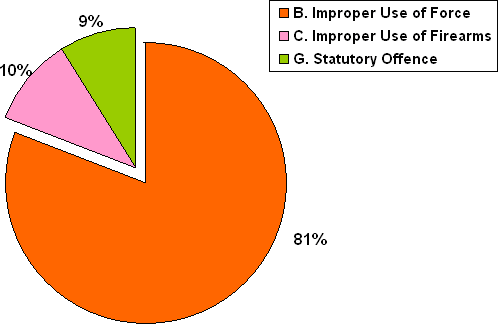
In 2008, there were 50 complaints capturing serious allegations that were purportedly withdrawn by the complainant. These complaints often included multiple but related allegations, 90 in total, which the Commission also deemed serious in nature. Some of these allegations included, but were not limited to: "Neglect of Duty", "Improper Attitude", and most notably, "Improper Arrest".
Terminations (Notice of Direction)40
A Notice of Direction is issued when the RCMP decides not to investigate a complaint or that the investigation into a complaint should be terminated. The RCMP may decide to terminate a complaint under three strict grounds provided for in paragraphs (a), (b) and (c) of subsection 45.36(5) of the RCMP Act: Essentially, the Commission believes a termination should not apply to a public complaint investigation if there is sufficient information to properly address the complaint in a Final Report.
A brief description of the termination paragraphs and under what circumstances they should be applied is described below:
Paragraph 45.36(5)(a)
Under paragraph 45.36(5)(a) of the Act, the RCMP may direct that no investigation be conducted or that an investigation be terminated if "the complaint is one that could more appropriately be dealt with, initially or completely, according to a procedure provided under any other Act of Parliament."
This paragraph is often applied when the complainant is involved in a related criminal proceeding which is ongoing. It is generally not reasonable to assume that a criminal proceeding designed to examine the conduct of the complainant will also examine the member conduct complained of, unless there is some information to the contrary. Therefore, the RCMP must ensure that it is reasonable to assume that the ongoing criminal proceeding will deal with each allegation identified in the public complaint.
A more appropriate use of this paragraph would be in the context of complaints relating to the improper disclosure of information, for example, when processes under the Privacy Act may be invoked to deal directly with the complaint allegation. It should be noted that civil proceedings and coroners' inquests, in particular, are not processes provided under federal statutes, and therefore this paragraph should not be applied.
Paragraph 45.36(5)(b)
Under paragraph 45.36(5)(b) of the Act, the Commissioner may direct that no investigation be conducted or that an investigation be terminated if, "the complaint is trivial, frivolous, vexatious or made in bad faith." An RCMP directive states as follows:
A complaint is trivial when, on its face, it is of no consequence. A complaint is frivolous when, on its face, it is devoid of substance. A complaint is vexatious when it involves a repetition of unsubstantiated complaints from the same person, all of which share a common theme. A complaint is made in bad faith when it is made dishonestly for an improper purpose. Bad faith normally requires the presence of two elements: firstly the desire to achieve an improper purpose and, secondly, an act of an improper nature furthering the improper purpose.
This paragraph should be invoked only where the allegations contain no substantial or compelling factual basis, where no rational argument is possible, and/or where each aspect of the allegation has been the subject of a previous public complaint by the same complainant. However, it should be noted that what may be trivial to one person may be quite important to another. Therefore, the investigator's subjective view of the complaint or complainant should not be a factor when deciding to apply this paragraph.
Paragraph 45.36(5)(c)
Paragraph 45.36(5)(c) is the most often applied paragraph. The RCMP may direct that no investigation be conducted or that an investigation be terminated if, "having regard to all the circumstances, investigation is not necessary or reasonably practicable."
Examples of terminations invoking this paragraph, and which have been found to be reasonable, include cases in which the complainant was incapable of providing any information that could provide the basis for further investigation within the public complaint process. However, an investigation should not be terminated only on the basis of the reluctance of the complainant to provide a statement as, in many cases, the initial complaint often provides sufficient information to conduct a thorough investigation. A termination will also be reasonable under this paragraph where the conduct complained of involved an individual who was not an RCMP member.
Quantitative Analysis of Terminations
In 2008, 6% of all public complaints, representing 275 allegations, were terminated by the RCMP; not surprisingly, the most common grounds for termination were paragraph (c), "investigation or further investigation is not necessary or reasonably practicable" (often perceived to be the "catch-all" termination provision). The allegation types that were most likely terminated, as opposed to any other types of disposition, were "Irregularity – Evidence", "Equipment", and "Oppressive Conduct".
Figure 11: Number of Terminated Complaints by Grounds Identified in subsection 45.36(5) of the RCMP Act
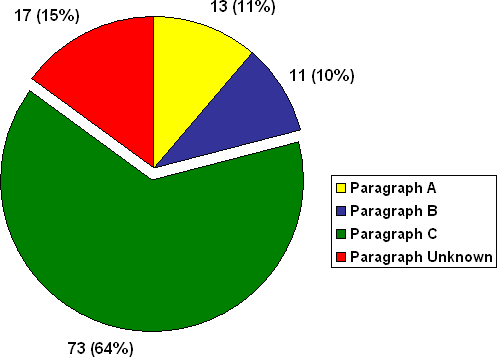
From a regional perspective, the Pacific Region disposed of 6% of its total public complaints through terminations, which addressed 138 total allegations. This is a decrease from 11% in 2007. Allegations most likely to be the subject of a termination paragraph were "Irregularity – Evidence" and "Improper Persons/Vehicles Search". The grounds for termination most likely to be identified in the Pacific Region were paragraph (c).
The Northwest Region disposed of 6% of its total public complaints through terminations, which addressed 101 allegations. This is a decrease from 11% in 2007. Allegations most likely to be the subject of a termination paragraph were "Oppressive Conduct" and "Mishandling of Property". The grounds for termination most likely to be invoked in the Northwest Region were paragraph (c).
The Central Region disposed of 19% of its total public complaints through terminations, which addressed 21 allegations. This is far above the Force-wide average, but a decrease from 25% in 2007. Allegations most likely to be the subject of a termination paragraph were "Neglect of Duty" and "Irregularity in Procedure". The grounds for termination most likely to be identified in the Central Region were paragraph (c).
The Atlantic Region disposed of 4% of its total public complaints through terminations, which addressed 15 total allegations. This is a decrease from 9% in 2007. Allegations most likely to be the subject of a termination paragraph were "Neglect of Duty" and "Improper Attitude". Most often, the grounds for termination were not identified.
The Commission notes that all of the Regions reported a decrease in issuing Notices of Direction. It remains unclear if the numbers associated with this disposition type have shifted to the number of Final Reports (or other disposition types).
Table7: Allegations Breakdown for Terminated Complaints41
| Pacific | Northwest | Central | Atlantic | Total | ||||||
|---|---|---|---|---|---|---|---|---|---|---|
| n | % | n | % | n | % | n | % | n | % | |
| A. Improper Attitude | 10 | 7% | 8 | 8% | 5 | 24% | 3 | 20% | 26 | 9% |
| B. Improper Use of Force | 22 | 16% | 9 | 9% | 0 | 0% | 1 | 7% | 32 | 12% |
| C. Improper Use of Firearms | 0 | 0% | 0 | 0% | 0 | 0% | 0 | 0% | 0 | 0% |
| D. Irregularity in Procedure | 13 | 9% | 10 | 10% | 3 | 14% | 1 | 7% | 27 | 10% |
| E. Driving Irregularity | 0 | 0% | 0 | 0% | 0 | 0% | 0 | 0% | 0 | 0% |
| F. Neglect of Duty | 35 | 25% | 34 | 34% | 6 | 29% | 6 | 40% | 81 | 29% |
| G. Statutory Offence | 0 | 0% | 5 | 5% | 3 | 14% | 0 | 0% | 8 | 3% |
| H. Mishandling of Property | 5 | 4% | 7 | 7% | 0 | 0% | 1 | 7% | 13 | 5% |
| I. Irregularity – Evidence | 7 | 5% | 2 | 2% | 0 | 0% | 2 | 13% | 11 | 4% |
| J. Oppressive Conduct | 19 | 14% | 17 | 17% | 3 | 14% | 1 | 7% | 40 | 15% |
| K. Improper Arrest | 4 | 3% | 2 | 2% | 0 | 0% | 0 | 0% | 6 | 2% |
| L. Improper Persons/Vehicles Search | 11 | 8% | 2 | 2% | 0 | 0% | 0 | 0% | 13 | 5% |
| M. Improper Search of Premises | 6 | 4% | 0 | 0% | 1 | 5% | 0 | 0% | 7 | 3% |
| N. Policy | 4 | 3% | 1 | 1% | 0 | 0% | 0 | 0% | 5 | 2% |
| O. Equipment | 0 | 0% | 2 | 2% | 0 | 0% | 0 | 0% | 2 | 1% |
| P. Service | 2 | 1% | 2 | 2% | 0 | 0% | 0 | 0% | 4 | 1% |
| Q. Other | 0 | 0% | 0 | 0% | 0 | 0% | 0 | 0% | 0 | 0% |
| Total | 138 | 100% | 101 | 100% | 21 | 100% | 15 | 100% | 275 | 100% |
Chronic and Multiple Complainants
The public complaint process is accessed by a variety of individuals who have concerns about the conduct of an RCMP member. Generally, one complaint relating to one incident is filed; however, some situations may necessitate the filing of two or more complaints, especially those spanning two divisions or detachments. These types of complainants are viewed as "multiple complainants".
Apart from the above-mentioned multiple complainants, there are a small percentage of complainants who are chronic in nature and file multiple complaints, spanning many years, and involving many different members and detachments. While their concerns should always be addressed, chronic complainants can put a strain on the resources of the RCMP public complaint process.42 For complaints lodged in 2008, the Commission found that of the 1,695 identified complainants, 131 or 8% could be considered multiple or chronic complainants.
Table 8: Repeat Complainants43
| Number of Complaints per Complainant | ||||||
|---|---|---|---|---|---|---|
| Region | 2 | 3 | 4 | 5 | 7 | Total |
| Pacific | 46 | 9 | 2 | 1 | 1 | 59 |
| Northwest | 42 | 6 | 2 | 0 | 0 | 50 |
| Central | 1 | 0 | 0 | 0 | 0 | 1 |
| Atlantic | 18 | 1 | 1 | 1 | 0 | 21 |
| Total | 107 | 16 | 5 | 2 | 1 | 131 |
Multiple Complaints against Individual Members
Multiple complaints against individual members for the 2008 calendar year were again tracked through the Review of the Record Project. A "repeat member" is a member who over the course of a year is the subject of two or more separate public complaints. It should be noted that a portion of these repeat members could be the subject of multiple complaints stemming from a single incident or multiple complaints from a multiple complainant.
It is conceivable that a member could legitimately generate multiple public complaints depending on the nature of the member's interaction with the public and, potentially, if he or she are posted to a small detachment. It is equally conceivable that a member could be generating multiple public complaints due to aggressive or inappropriate on-duty behaviour. The context of the public complaint would best determine which of the two scenarios presented above was most accurate. In the future, the Commission will be able to identify which members have multiple complaints against them spanning a number of years as well as the nature of these complaints. As the database grows there exists a greater opportunity to conduct further analysis into these statistics. The Commission is aware that at least one RCMP division utilizes multiple complaints as an "early warning" signal.44 The Commission supports this practice and encourages the RCMP to consider implementing such a process nation-wide.
A total of 295 members had two or more complaints lodged against them, which represented 13% of the total number of members named in complaints. 45 Although most of the members had only two (2) complaints, some members had as many as five (5) complaints lodged against them in 2008 alone. Of these multiple complaint members, 136 were members in "E" Division, 81 were from "K" Division, and 23 were from "J" Division.
Of the 1,391 allegations lodged against members who had multiple complaints, the most common types were "Improper Attitude" (24%), "Neglect of Duty" (24%), and "Improper Use of Force" (13%). Interestingly, when members had four or more complaints lodged against them the primary allegation type was "Improper Attitude", which represented over 30% of the total.
Table 9: Repeat Members
| Number of Complaints per Member | |||||
|---|---|---|---|---|---|
| Region | 2 | 3 | 4 | 5 | Total |
| Pacific | 113 | 26 | 2 | 2 | 143 |
| Northwest | 106 | 17 | 4 | 0 | 127 |
| Central | 3 | 1 | 0 | 0 | 4 |
| Atlantic | 33 | 6 | 1 | 0 | 40 |
| Total | 255 | 50 | 7 | 2 | 314 |
Service Standards: Processing Time46
The Commission has implemented performance-based service standards for each step of the complaint and review processes that are under its control. These improvements have enhanced the ability of complainants, RCMP members and Canadians to hold the Commission and the RCMP accountable for a timely response to public complaints. However, a large portion of the public complaint process is under the control of the RCMP, and it was hoped that Force-wide service standards would be introduced to further enhance this aspect of public accountability.
The Commission is pleased to report that in 2008 the RCMP took, on average, 103 days to issue a disposition once a complaint was lodged. This is an 11-day reduction in processing time from 114 days in 2007. Interestingly, on average, 20047 days elapsed before a complainant lodged a complaint after the incident of concern, on average; this is down from an average of 229 days in 2007.
Further broken down by disposition type, the timelines are as follows:
- On average, 149 days to issue a Final Report.
- On average, 66 days to enter into an Informal Resolution.
- On average, 72 days to accept a Withdrawal.
- On average, 64 days to issue a Notice of Direction.
Figure 12: Complaint Timeline By Region
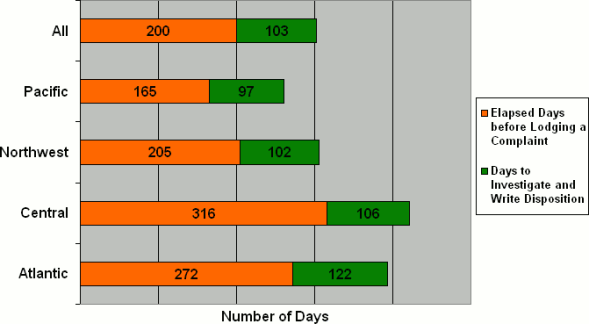
In the Pacific Region, on average, 165 days elapsed before a complainant lodged the original complaint. Once the complaint was received, it took, on average, 97 days for the divisions within this region to complete a disposition; this is a 12-day reduction 2007. Further broken down by disposition type, the timelines are as follows.
- On average, 135 days to issue a Final Report:
- On average, 73 days to enter into an Informal Resolution.
- On average, 73 days to accept a Withdrawal.
- On average, 69 days to issue a Notice of Direction.
The average number of days that elapsed before a complainant in the Northwest Region lodged the original complaint was 205. Once the complaint was received, the divisions within this region took, on average, 102 days to complete a disposition. This is an 18-day reduction from 2007. Further broken down by disposition type, the timelines are as follows:
- On average, 168 days to issue a Final Report.
- On average, 55 days to enter into an Informal Resolution.
- On average, 66 days to accept a Withdrawal.
- On average, 69 days to issue a Notice of Direction.
In the Central Region, on average, 316 days elapsed before a complainant lodged the original complaint. Once the complaint was received it took, on average, 106 days for divisions within this region to complete a disposition, this is a three (3)-day increase from 2007. Further broken down by disposition type, the timelines are as follows:
- On average, 146 days to issue a Final Report.
- On average, 27 days to enter into an Informal Resolution.
- On average, 38 days to accept a Withdrawal.
- On average, 46 days to issue a Notice of Direction.
The average number of days that elapsed before a complainant in the Atlantic Region lodged the original complaint was 272 days. Once received the divisions within this region took, on average, 122 days to complete a disposition. This is an increase from the average of 115 days in 2007. Further broken down by disposition type, the timelines are as follows:
- On average, 147 days to issue a Final Report.
- On average, 80 days to enter into an Informal Resolution.
- On average, 94 days, to accept a Withdrawal.
- On average, 42 days to issue a Notice of Direction.
The Commission has also attempted to determine if there was a difference with respect to these averages between Commission-lodged complaints and RCMP-lodged complaints. On average, complainants waited 223 days after the incident took place before lodging the original complaint directly with the Commission, while complaints lodged with the RCMP averaged only 142 days after the incident. This is an improvement from 2007, where it took, on average, 271 days after the incident took place before lodging the original complaint directly with the Commission while complaints lodged with the RCMP averaged only 165 days after the incident.
Providing Dispositions to the Commission
The RCMP is required to provide the Commission copies of all dispositions for its analyses. To that end, the average number of days48 for the Commission to receive the complaint disposition from the RCMP as a whole was 73 days for Commission-lodged complaints as opposed to the 61 days it took for RCMP-lodged complaints. This is an improvement from 2007, where it took, on average, 95 days for Commission-lodged complaints and 72 days for RCMP-lodged complaints.
This average was also examined regionally:
In the Pacific Region, it took 95 days for Commission-lodged complaints as opposed to 82 days for RCMP-lodged complaints. This can be compared to 2007 where it took 95 days for Commission-lodged complaints and 69 days for RCMP-lodged complaints.
In the Northwest Region, it took 62 days for Commission-lodged complaints as opposed to 64 days for RCMP-lodged complaints; compared to 2007 where it took 110 days for Commission-lodged complaints and 87 days for RCMP-lodged complaints, a significant improvement.
In the Central Region, it took 42 days for Commission-lodged complaints as opposed to 28 days for RCMP-lodged complaints. This is in comparison to 2007 where it took 66 days for Commission-lodged complaints as opposed to 67 days for RCMP-lodged complaints; a significant improvement.
In the Atlantic Region, it took 23 days for Commission-lodged complaints as opposed to 25 days for RCMP-lodged complaints. This is in comparison to 2007 where it took 66 days for Commission-lodged complaints and 53 days for RCMP-lodged complaints; a significant improvement.
Figure 13: Complaint Timeline – Comparison Based on Where the Complaint Was Lodged
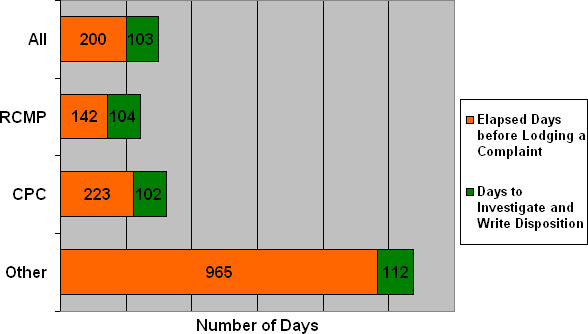
The average number of days to issue a disposition was 102 for Commission-lodged complaints as opposed to 104 days for RCMP-lodged complaints. This is an improvement from 2007, where it took, on average, was 118 for Commission-lodged complaints and 108 days for RCMP-lodged complaints.
Complaint timelines were also determined by allegation type for the three most common allegations:
- For allegations of "Neglect of Duty", it took, on average, 109 days for the RCMP to issue a disposition. On average, it took a complainant 236 days after the incident date to file a complaint for this type of allegation.
- For allegations of "Improper Attitude", it took, on average, 98 days for the RCMP to issue a disposition. On average, it took a complainant 153 days following the incident date to lodge a complaint for this type of allegation.
- For allegations of "Improper Use of Force", it took, on average, 143 days for the RCMP to issue a disposition. On average, it took a complainant 173 days following the incident date to lodge a complaint for this type of allegation.
Administrative Issues
Incomplete Complaint Records
Occasionally, the Commission received complaint dispositions that were incomplete in that documents were missing or identifying information related to members or complainants was not provided. Of these complaints, the Commission received 183 incomplete records, representing 10% of the total dispositions received for complaints lodged in 2008; down 4% from 2007. Regionally, 4% of complaint records from the Pacific Region were incomplete, 14% from the Northwest Region, 17% from the Central Region and 17% from the Atlantic Region.
Incorrect Commission Reference49
When issuing a Final Report or Notice of Direction, the RCMP is required by statute to inform the complainants of their right to request a review of their Final Report and Notice of Direction. The Commission has received dispositions that have an incorrect reference or that do not include this reference at all. In 2008, the Commission received 51 such dispositions: 30 from the Pacific Region, eight (8) from the Northwest Region, three (3) from the Central Region and 10 from the Atlantic Region.
Issues with Quality of Dispositions
A variety of administrative issues with dispositions provided by the RCMP have created difficulties for the Review of the Record Project. Incomplete Forms 4110 and poorly structured Final Reports and Notices of Direction have made the Commission's task of capturing data related to public complaints a difficult one.
There is currently no up-to-date national policy or handbook for the RCMP in relation to the completion of dispositions and corresponding Form 4110. As such, the Commission has undertaken the process of creating a best practices portion of its website for members to reference when completing public complaint dispositions.
It is hoped that with this addition, Forms 4110 will be filled out properly and entirely, and Letters of Disposition will be clearer, more concise, and better suit the needs of the RCMP, the Commission and the complainants.
Part Two: Outstanding Disposition List
Outstanding Disposition List
The Outstanding Disposition List is designed to act as an accounting mechanism for all Commission-lodged complaints that are currently being investigated by the RCMP.50 Information gathered through the Outstanding Disposition List allows the Commission to track how quickly the RCMP is responding to complaints, identify if complaints are taking too long to be investigated, and ultimately hold the RCMP accountable to the public.
A list of outstanding complaints has been provided to the RCMP on a regular basis throughout the year. The list is submitted to the RCMP every three months and identifies complaints that have been outstanding for 180 days or more. Deletions and additions are made to the list as complaint dispositions are received and new complaints are lodged.
The RCMP, in recent months, has made strides to provide the Commission with dispositions in a timelier manner and endeavoured to eliminate the outstanding complaints that were lodged prior to 2007, as the Commission tracks complaints that were lodged before January 1, 2007.
The Outstanding Disposition List has also been able to identify and track those complaints which have been outstanding for what the Commission deems to be an unreasonable amount of time: 750 days or longer.51 The RCMP, largely, has been receptive to this and made a noticeable effort to get these dispositions to the Commission. The results of this can be seen in the increased number of dispositions provided to the Commission, which received 785 complaint dispositions in 2008; this is a 22% increase from 2007. This increased output is in addition to the extraordinary effort put forth with respect to the Outstanding Disposition List project, the results of which are further examined in the following section. The majority of these long outstanding dispositions can be traced to "E" Division; however, it should be noted that this division has dedicated more resources to addressing the outstanding public complaint dispositions and has proactively instituted measures to provide the Commission with documents in a timelier manner.
The first reconfigured list since the release of the 2007 Review of the Record Report was sent to the RCMP in August 2008. Within three months of the list being sent, 311 complaint dispositions were provided to the Commission. In January 2009, a second list was sent. By April 2009, the Commission received 282 complaint dispositions from files appearing on the second list. Finally, in April 2009, a third list was sent resulting in 458 dispositions being sent to the Commission by July 2009.
Figure 14: Number of Pre-2007 Outstanding Complaint Dispositions
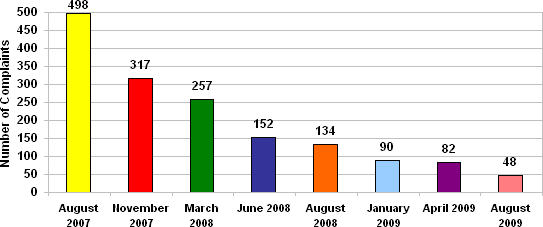
Since the 2007 Review of the Record Report was released, when it was reported that there were 152 remaining complaints from prior to January 1, 2007, the RCMP has been able to further reduce this number by 68%; with only 48 dispositions that remain outstanding. This is a significant achievement. As noted below, "E" Division accounts for 96% of the remaining outstanding dispositions beyond the 750-day threshold.
Figure 15: Complaints Outstanding 750 Days or More By Division
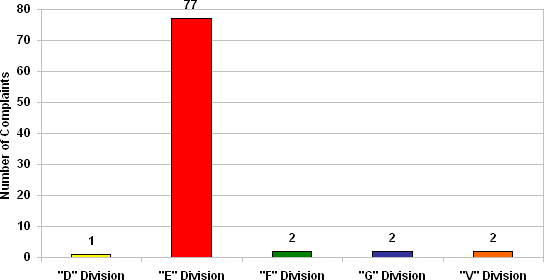
The Outstanding Disposition List is able to present data in a multitude of ways, not the least important of which is by listing outstanding dispositions by their corresponding detachments. As such, the Commission is able to monitor the progress of individual detachments in ensuring that public complaints are disposed of within a reasonable timeframe. As of August 1, 2009, the Surrey Detachment had 82 dispositions outstanding beyond the 180-day threshold, the oldest being 2,239 days outstanding (over six years). However, detachments like Coquitlam, Wood Buffalo, and Whitehorse are but a few of many detachments whose record of complaint resolution and providing dispositions to the Commission is commendable.
Divisions have been very involved in providing feedback to the Commission and in maintaining the integrity of the Outstanding Disposition List. However, administrative issues with the Professional Standards and External Review Directorate were made evident in June 2009, when an effort was made to harmonize the RCMP's national list of complaints with the Commission's lists.
Due to what appears to be processing delays, the record keeping concerns and resource limitations, the Professional Standards and External Review Directorate was unable to provide the Commission with the 347 documents identified as missing through the harmonization process by the July 1, 200952 project deadline. This is similar to what occurred when the Commission was compiling the 2007 Review of the Record Report when over 200 identified documents were not provided.
This setback effectively penalized the detachments and divisions which had previously sent dispositions to the Professional Standards and External Review Directorate, as these dispositions were not received in time to be included in the statistical analysis of this report. Their exclusion from the 2008 Quantitative Analysis section is an unfortunate consequence and it is hoped that the record keeping issues at the Professional Standards and External Review Directorate will be rectified in time for the 2009 report. It is clear that there are significant problems at the Professional Standards and External Review Directorate that are negatively impacting the proper functioning of the RCMP public complaint process.
However, in order to be fair to the detachments and divisions that had sent dispositions on time, those received after the July 1, 2009 deadline were considered when analyzing the available data for the Outstanding Disposition List, as the deadline specific to this aspect of the project was extended to August 1, 2009.
Follow-Up on Complaint Dispositions
The Commission's efforts at following up on questions raised in the analysis of the completed complaint record is an example of the high degree of cooperation possible between the Review of the Record Unit, Professional Standards and External Review Directorate and divisional Professional Standards. Most times these requests were to obtain missing documents; however, other requests went so far as to have complaints sent back to detachments for additional information to assist in a proper analysis or to recommend an investigation into the allegations.
The RCMP's cooperation with this aspect of the Review of the Record Project has been commendable. In many cases, the Commission's requests were met within days. Although there were examples of long outstanding requests, the average length of a follow-up request to be made and a resolution to be offered was 33 days.
There were 62 follow-up requests for complaints lodged in 2008; only ten (10) remained open at the time of this Report. Of the closed follow-ups, the Commission's concerns and requests were met in 87% of the cases.
As identified, the reasons for follow-ups were primarily centered on two issues: missing documents and improper use of force complaints informally resolved. The other issues included: incomplete records, unclear dispositions, improper CPC references, use of force complaints withdrawn, and other.
Figure 16: Breakdown of 2008 Follow-Up Issues
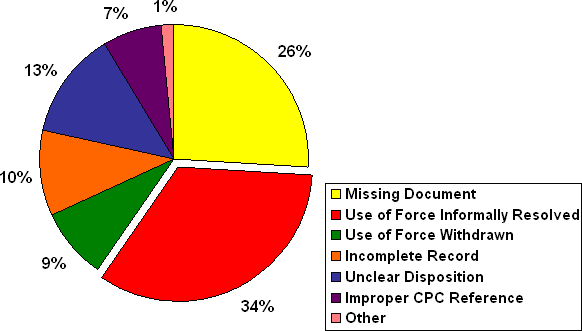
The divisional breakdown of the follow-ups does not indicate any particular Commission concerns with specific regions. Instead, the follow-ups tended to be relatively proportional to the overall number of complaints received.
Figure 17: Breakdown of Follow-Ups by Division
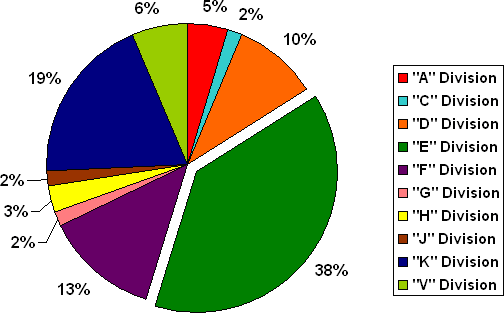
Twenty-five follow-ups (40%) were resolved within ten (10) days of a Commission's request. The majority of these timely responses were related to missing documentation, but nonetheless are examples of the RCMP's strong willingness to cooperate with the Commission in ensuring the integrity of the public complaint process.
Still problematic, however, is the apparent inability to cease, or to at least clarify, the practice of informally resolving complaints involving serious allegations.53 Despite the positive response to the Commission's requests there were several cases where the RCMP refused to investigate a serious allegation once it had been resolved informally. It must be noted that under the current legislation the Commission does not have the power to force the RCMP to investigate a complaint. Accordingly, while the RCMP may choose to refuse the Commission's request to investigate even when it involves serious allegations such as improper use of force or when injuries have allegedly been sustained,54 this practice is contrary to RCMP policy. Moreover, the Commission does retain the authority pursuant to the RCMP Act to launch a Chair-initiated complaint and/or public interest investigation into such a matter if the RCMP refuses to properly investigate the complaint in the first instance.
There was a case where the Commission recommended an investigation into a complaint alleging "Improper Use of Force", which was informally resolved after the RCMP explained the IM/IM model and arrest procedures to the complainant. Based on the seriousness of the allegations and the lack of information regarding the nature of force used, the Commission believed that an investigation was warranted or, at the very least, further information should be provided. However, the RCMP maintained that the informal resolution was appropriate, especially since the complainant was satisfied with the explanation and noted, "as he was not injured during the course of his arrest or time in custody." Given the circumstances, an informal resolution of this complaint did not appear to be appropriate and it would have been more prudent for the RCMP to provide further details of the force used against the complainant.
Another example where the Commission believed an investigation was warranted yet the RCMP was not willing to cooperate in that regard, involved alleged "Improper Use of Force" and "Improper Use of Firearms". It was alleged that a civilian present at the scene was handed, by the RCMP members, pepper spray (OC spray), and that members effecting the arrest of the subject used improper and excessive force. The Commission strongly recommended a formal investigation. The RCMP, however, indicated that "there is absolutely no need to perform such an investigation, with the members acting completely appropriate given the circumstances they were presented with." Given that it appeared as though determinations were being made regarding member conduct, and that the concerns of the Commission had not been fully addressed, an informal resolution did not seem to be the most appropriate disposition of this complaint.
It should be noted that although some of the Commission's requests have been declined at times, there were also examples of investigations being undertaken in response to concerns raised over use of force complaints informally resolved. Such a response is evidence that the follow-up process was able to quickly address improperly resolved complaints and for which may otherwise have gone unnoticed.
In an instance where the RCMP satisfied the Commission's concerns regarding a follow-up, the Commission's concern with an informally resolved complaint alleging excessive force was reciprocated, and an investigation was initiated, with the RCMP noting: "[...] we were informed by Professional Standards & External Review Directorate that all allegations involving the serious use of force will be formally investigated. As a result, I am now ordering that a formal investigation be conducted into this allegation and that a comprehensive report be forwarded to this office [...]." In another instance, a complainant who sustained a broken wrist during the course of an arrest entered into an informal resolution with the RCMP. Given the presence of an injury, the Commission questioned if this type of disposition was appropriate. The RCMP agreed to investigate the complaint formally following the Commission's follow-up.
Often the complaint dispositions did not provide sufficient details about the incident to determine what the circumstance of the interaction was and if the disposition was appropriate. The Commission made numerous requests for additional information in complaints which alleged improper use of force yet lacked sufficient detail to determine if an investigation was warranted. Frequently, the RCMP response was sufficient in satisfying the Commission's concerns. In 12 of the 23 (52%) follow-ups related to "Improper Use of Force" complaints informally resolved, the RCMP's additional explanation of the informal resolution process, as well as clearer details of the incidents in question, indicated that the informal resolutions were indeed appropriate. It should be noted that had the RCMP provided sufficient detail on the Form 4110 and properly captured the informal resolution in the first instance, it would have mitigated the need for additional requests and increased workload.
Interestingly, in response to the Commission's repeated requests for additional information with respect to complaints which alleged improper use of force and lacked sufficient details, divisional Professional Standards have taken proactive steps to gather and provide additional details explaining actions and outcomes along with the dispositions themselves. This has been most evident with "E" Division and has considerably reduced the need for follow-ups of this nature.
There were also cases of informally-resolved complaints based on the complainant being read an investigator's report, or at times being briefed by the investigator. In these instances, the Commission believes the RCMP incorrectly circumvented the need for a Final Report by simply reviewing with the complainant the findings of the RCMP investigation. If an investigation has been conducted and findings made the more prudent course of action would be to issue a Final Report.
With respect to withdrawals, there was typically a lack of in-depth descriptions of events or details regarding the reasons for requesting a withdrawal. This was especially problematic with complaints that included serious allegations. At times, withdrawal letters from complainants may speak about why they are withdrawing their complaints, and at times complainants do not feel anything will come of their complaint. Under these circumstances, the Commission has requested more information and depending on the degree of interaction during the withdrawal process, indicated to the RCMP that an investigation appeared warranted.
In lieu of a national handbook for best practices related to public complaints, the follow-up process allows the Commission to interact, via Professional Standards, with individual detachments that are responsible for handling complaints and address concerns in an informal manner. Based on the above assessment, it is clear that more training for authors of disposition reports as well as for public complaint investigators is warranted and would vastly improve the quality and integrity of the process.
Recommendations
Recognizing the importance of RCMP-wide consistency and based on the findings of the analyses within the Review of the Record Project, the Commission recommends to the Commissioner of the RCMP the following:
- That the RCMP immediately implement the recommendations made by the Commission in its Review of the RCMP's Public Complaints Records-2007 report.
- That the Professional Standards and External Review Directorate at RCMP Headquarters immediately implement a proper database to track public complaints and related processes so that this Directorate will be able, at a minimum, to identify when complaints were lodged, how many have been lodged, where they were lodged, the members involved, what the nature of the complaints are and if an investigation or appropriate disposition has been completed on a national level.
- That the RCMP ensure that those tasked with capturing public complaints and writing complaint dispositions receive complete and ongoing training and that manuals related to the public complaint process be immediately updated to ensure a standardized national approach.
- That the RCMP commit to improving its service standards by implementing ways to reduce wait times and reduce processing times for complaint dispositions.
- That the Professional Standards and External Review Directorate at RCMP Headquarters immediately issue a directive to RCMP members clearly articulating:
- What constitutes "serious allegations" and when it is appropriate to informally resolve improper use of force complaints and when it is not;
- how public complaints defined under Part VII of the RCMP Act are to be processed when the complainant raises statutory offence allegations; and
- when it is appropriate to terminate a public complaint under the RCMP Act and what information must be included in a Notice of Direction.
- That the RCMP amend its policies (as required) regarding the withdrawal of complaints to ensure that it's policies clearly articulate when it is appropriate to accept a purported withdrawal of a complaint making "serious allegations"; and that the reasons for the withdrawal are clearly documented on the withdrawal forms.
- That the Commissioner of the RCMP, to enhance consistency and adherence to policy, revise his delegated authority with respect to the issuance of Notices of Direction for terminations from the unit level to, at least, the level of officer (or non-commissioned officer) in charge of the Divisional Professional Standards units.
- That the RCMP implement a national program whereby multiple complaints will be utilized as an "early warning" of potential conduct-related concerns with individual RCMP members.
- That the RCMP commit to initiate a detailed examination into the entire RCMP public complaint process in the Territories. The Commission is amenable to working jointly with the RCMP with respect to this recommendation.
Appendix A: Common Terminology
...........................................................................................................
...........................................................................................................
...........................................................................................................
...........................................................................................................
...........................................................................................................
...........................................................................................................
...........................................................................................................
...........................................................................................................
Commissioner's Notice
...........................................................................................................
...........................................................................................................
...........................................................................................................
...........................................................................................................
...........................................................................................................
...........................................................................................................
...........................................................................................................
...........................................................................................................
...........................................................................................................
...........................................................................................................
Appendix B: List of Issues55
...........................................................................................................
...........................................................................................................
(not intoxication)
...........................................................................................................
...........................................................................................................
...........................................................................................................
...........................................................................................................
...........................................................................................................
...........................................................................................................
...........................................................................................................
/No child
...........................................................................................................
...........................................................................................................
...........................................................................................................
...........................................................................................................
...........................................................................................................
...........................................................................................................
...........................................................................................................
...........................................................................................................
...........................................................................................................
...........................................................................................................
...........................................................................................................
...........................................................................................................
...........................................................................................................
...........................................................................................................
...........................................................................................................
...........................................................................................................
...........................................................................................................
...........................................................................................................
...........................................................................................................
...........................................................................................................
...........................................................................................................
...........................................................................................................
...........................................................................................................
...........................................................................................................
...........................................................................................................
...........................................................................................................
...........................................................................................................
...........................................................................................................
...........................................................................................................
...........................................................................................................
...........................................................................................................
...........................................................................................................
...........................................................................................................
...........................................................................................................
...........................................................................................................
Appendix C: List of Allegations
There are 16 RCMP complaint categories:
- Improper Attitude: The complaint category includes behaviour that could be seen as abusive, rude, discourteous, disrespectful, aggressive, intimidating, etc. The behaviour could also be seen to be unfair or lacking empathy.
- Improper Use of Force: The category includes allegations of inappropriate or excessive force. Improper use of force may be considered inconsistent with circumstances applied to frequently or harshly.
- Improper Use of Firearms: This category involves the use, display or discharge of a firearm.
- Irregularity in Procedure: This complaint category involves some aspect of the Privacy or Access issues, allegations that members improperly obtained information from a police data bank, and other alleged violations of an "administratively enforced" statute.
- Driving Irregularity: This complaint category includes allegations of improper or unsafe police transport, pursuits or operation of emergency vehicles.
- Neglect of Duty: This is a broad category that encompasses alleged behaviour that a member failed to or refused to perform a duty or provide an expected service. Such allegations could include failure to identify oneself, mismanagement of public complaints, inadequate investigations, improper care of prisoners, failure to release detained persons into a safe environment, and failure to provide appropriate medical care. This category could also include allegations of deficient reporting related to note books, investigations, occurrence reports.
- Statutory Offence: This complaint category is reserved for allegations that members violated sections of the Criminal Code of Canada, federal, provincial or municipal statutes.
- Mishandling of Property: This complaint category includes allegations about the loss of property, damage to property and the unreasonable detention of property.
- Irregularity-Evidence: These allegations would include concerns around members testifying in judicial proceedings, failure or refusal to report the facts of a public complaint, and failure or refusal to testify to correct or true facts.
- Oppressive Conduct: The complaint category would include these allegations that would surpass what would be considered improper attitude, irregular procedure and neglect of duty.
- Improper Arrest: This category involves allegations of failing to inform an individual for the reason for their arrest, right to counsel or failing to provide an opportunity to exercise these rights.
- Improper Persons/Vehicles Search: These allegations would include complaints of personal and vehicle searches as well as potential violations of section 8 of the Charter of Rights and Freedoms.
- Improper Search of Premises: The complaint category includes allegations concerning members who have entered or remain unlawfully in a premise.
- Policy: These allegations are specifically about RCMP policy and their application.
- Equipment: This category applies to allegations of improper use of RCMP equipment.
- Service: This complaint category includes allegations that members did not respond or failed to provide timely service.
Appendix D: Map of RCMP Divisions
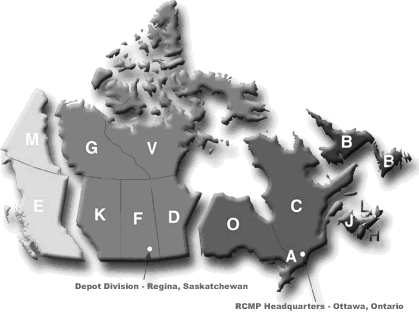
The regions and their associated divisions are as follows:
Pacific Region:
"E" Division: British Columbia
"M" Division: Yukon
Northwest Region:
"V" Division: Nunavut
"D" Division: Manitoba
"F" Division: Saskatchewan
"K" Division: Alberta
"G" Division: Northwest Territories
Central Region:
"C" Division: Quebec
"O" Division: Ontario
"A" Division: National Capital Region
Atlantic Region:
"B" Division: Newfoundland and Labrador
"H" Division: Nova Scotia
"J" Division: New Brunswick
"L" Division: Prince Edward Island
Appendix E: Public Complaint Process
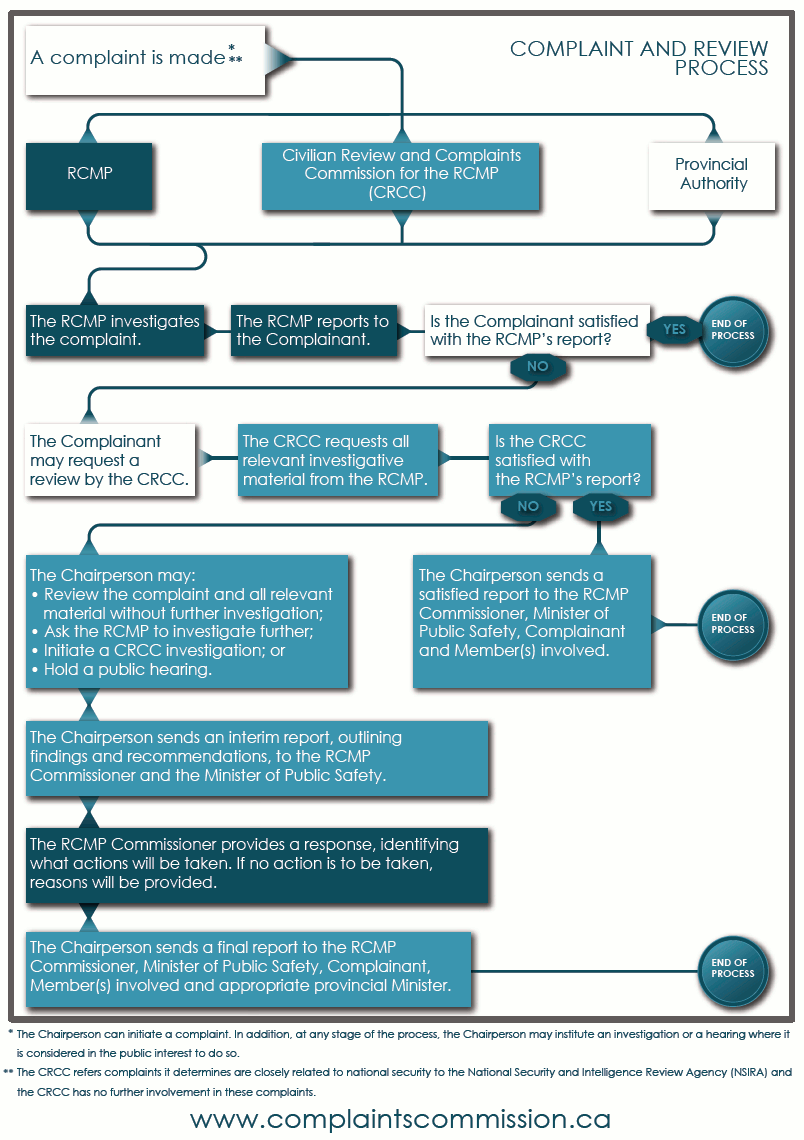
Appendix F: Yearly Comparison – At A Glance
| 2007 Report | 2007 Update | 2008 Report | ||||
|---|---|---|---|---|---|---|
| Complaints | # | % | # | % | # | % |
| Atlantic | 236 | 16% | 267 | 14% | 259 | 14% |
| Central | 53 | 4% | 62 | 3% | 64 | 3% |
| Northwest | 509 | 35% | 698 | 38% | 692 | 38% |
| Pacific | 642 | 45% | 834 | 45% | 814 | 45% |
| Total | 1,440 | 1,861 | 1,829 | |||
| Lodged With: | # | % | # | % | # | % |
| Commission (CPC) | 870 | 60.4% | 1,098 | 59.0% | 1,238 | 67.7% |
| RCMP | 564 | 39.2% | 750 | 40.3% | 584 | 31.9% |
| FSIN | 6 | 0.4% | 9 | 0.5% | 4 | 0.2% |
| Alb. Sol. Gen | 0 | 0.0% | 4 | 0.2% | 3 | 0.2% |
| Total | 1,440 | 1,861 | 1,829 | |||
| Dispositions | # | % | # | % | # | % |
| Final Report | 659 | 46% | 921 | 49% | 785 | 42.92% |
| Informal Resolution | 438 | 30% | 541 | 29% | 629 | 34.39% |
| Withdrawal | 191 | 13% | 231 | 12% | 301 | 16.46% |
| Termination | 152 | 11% | 168 | 9% | 114 | 6.23% |
| Total | 1,440 | 1,861 | 1,829 | |||
| Allegations | # | % | # | % | # | % |
| A. Improper Attitude | 615 | 19.8% | 860 | 20.1% | 980 | 21.7% |
| B. Improper Use of Force | 412 | 13.3% | 663 | 15.5% | 470 | 10.4% |
| C. Improper Use of Firearms | 13 | 0.4% | 15 | 0.4% | 37 | 0.8% |
| D. Irregularity in Procedure | 194 | 6.3% | 310 | 7.2% | 424 | 9.4% |
| E. Driving Irregularity | 38 | 1.2% | 57 | 1.3% | 54 | 1.2% |
| F. Neglect of Duty | 893 | 28.8% | 1,168 | 27.3% | 1,326 | 29.4% |
| G. Statutory Offence | 115 | 3.7% | 187 | 4.4% | 118 | 2.6% |
| H. Mishandling of Property | 69 | 2.2% | 84 | 2.0% | 102 | 2.3% |
| I. Irregularity – Evidence | 46 | 1.5% | 48 | 1.1% | 44 | 1.0% |
| J. Oppressive Conduct | 283 | 9.1% | 364 | 8.5% | 307 | 6.8% |
| K. Improper Arrest | 184 | 5.9% | 236 | 5.5% | 266 | 5.9% |
| L. Improper Persons/Vehicles Search | 45 | 1.4% | 63 | 1.5% | 106 | 2.3% |
| M. Improper Search of Premises | 85 | 2.7% | 95 | 2.2% | 129 | 2.9% |
| N. Policy | 11 | 0.4% | 18 | 0.4% | 44 | 1.0% |
| O. Equipment | 5 | 0.2% | 8 | 0.2% | 13 | 0.3% |
| P. Service | 87 | 2.8% | 97 | 2.3% | 86 | 1.9% |
| Q. Other | 9 | 0.3% | 9 | 0.2% | 5 | 0.1% |
| Total | 3,104 | 4,282 | 4,511 | |||
| Timeline | # | % | # | % | # | % |
| Number of Days to Lodge Complaint | 229 | N/A | 219 | N/A | 200 | N/A |
| Number of Days to Issue Disposition | 114 | N/A | 150 | N/A | 103 | N/A |
| Number of Days to Receive Disposition | 86 | N/A | 119 | N/A | 69 | N/A |
| Issues | # | % | # | % | # | % |
| Aboriginal Community | 22 | 0.6% | 46 | 0.9% | 74 | 1.3% |
| Abusive Language | 84 | 2.3% | 111 | 2.1% | 118 | 2.1% |
| Alcohol or Drugs (not intoxication) | 80 | 2.2% | 110 | 2.1% | 116 | 2.1% |
| Arrest | 355 | 9.6% | 512 | 9.9% | 447 | 7.9% |
| Attitude | 606 | 16.3% | 788 | 15.3% | 876 | 15.6% |
| Care in Custody | 64 | 1.7% | 75 | 1.5% | 67 | 1.2% |
| Chemical Irritant | 31 | 0.8% | 53 | 1.0% | 20 | 0.4% |
| Child Abuse Response | 15 | 0.4% | 24 | 0.5% | 39 | 0.7% |
| Child Custody | 21 | 0.6% | 30 | 0.6% | 31 | 0.6% |
| Civil Disputes/No Child | 40 | 1.1% | 56 | 1.1% | 74 | 1.3% |
| Conflict of Interest | 14 | 0.4% | 31 | 0.6% | 39 | 0.7% |
| Criminal Investigation Quality (RCMP) | 402 | 10.8% | 497 | 9.6% | 519 | 9.2% |
| Crowd Control | 10 | 0.3% | 11 | 0.2% | 3 | 0.1% |
| Custody Deaths | 8 | 0.2% | 11 | 0.2% | 5 | 0.1% |
| Detention | 120 | 3.2% | 178 | 3.4% | 161 | 2.9% |
| Entry of Premises | 84 | 2.3% | 109 | 2.1% | 81 | 1.4% |
| Informants/Sources | 5 | 0.1% | 7 | 0.1% | 19 | 0.3% |
| Intoxication | 102 | 2.8% | 190 | 3.7% | 210 | 3.7% |
| Lethal Weapons | 19 | 0.5% | 25 | 0.5% | 37 | 0.7% |
| Lying under Oath | 27 | 0.7% | 29 | 0.6% | 12 | 0.2% |
| Medical Care | 73 | 2.0% | 96 | 1.9% | 111 | 2.0% |
| Mental Illness | 73 | 2.0% | 83 | 1.6% | 69 | 1.2% |
| National Security | 0 | 0.0% | 1 | 0.0% | 2 | 0.0% |
| Non-custody Deaths | 1 | 0.0% | 3 | 0.1% | 10 | 0.2% |
| Non-lethal weapons other than chemical irritants | 52 | 1.4% | 79 | 1.5% | 40 | 0.7% |
| Non-pursuit Police Driving | 14 | 0.4% | 27 | 0.5% | 29 | 0.5% |
| Non-spousal, Non-child Assault Response | 51 | 1.4% | 84 | 1.6% | 110 | 2.0% |
| Non-spousal, Non-child Sexual Assault Response | 17 | 0.5% | 19 | 0.4% | 12 | 0.2% |
| Note-taking Quality | 6 | 0.2% | 9 | 0.2% | 12 | 0.2% |
| Other (if necessary) | 59 | 1.6% | 59 | 1.1% | 0 | 0.0% |
| Police Dogs | 9 | 0.2% | 13 | 0.3% | 23 | 0.4% |
| Police Physical Abuse | 169 | 4.6% | 287 | 5.6% | 238 | 4.2% |
| Police Pursuit Driving | 9 | 0.2% | 12 | 0.2% | 21 | 0.4% |
| Policy | 37 | 1.0% | 43 | 0.8% | 54 | 1.0% |
| Property Mishandling | 61 | 1.6% | 89 | 1.7% | 109 | 1.9% |
| Public Complaint Process Quality (RCMP) | 84 | 2.3% | 93 | 1.8% | 44 | 0.8% |
| Release/Disclosure of Information | 48 | 1.3% | 66 | 1.3% | 75 | 1.3% |
| Restraints | 63 | 1.7% | 84 | 1.6% | 66 | 1.2% |
| Right to Counsel | 54 | 1.5% | 73 | 1.4% | 58 | 1.0% |
| Search | 118 | 3.2% | 155 | 3.0% | 186 | 3.3% |
| Seizure | 79 | 2.1% | 99 | 1.9% | 87 | 1.5% |
| Service | 168 | 4.5% | 285 | 5.5% | 680 | 12.1% |
| Spousal Abuse Response | 55 | 1.5% | 62 | 1.2% | 57 | 1.0% |
| Vehicular Incidents | 262 | 7.1% | 374 | 7.2% | 449 | 8.0% |
| Witness Protection Program | 0 | 0.0% | 1 | 0.0% | 4 | 0.1% |
| Youth Interaction With RCMP | 38 | 1.0% | 59 | 1.1% | 75 | 1.3% |
| Youth Involvement | N/A | N/A | 16 | 0.3% | 54 | 1.0% |
| Total | 3,709 | 5,164 | 5,623 | |||
Complaint Timeline By Year
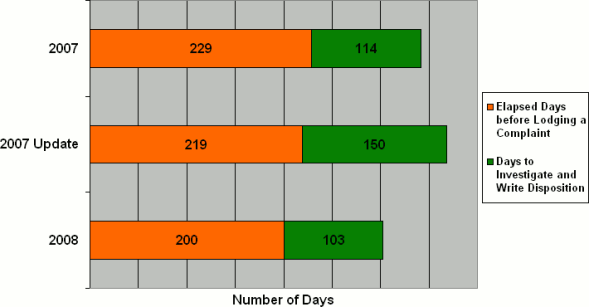
Appendix G: Termination Flowchart
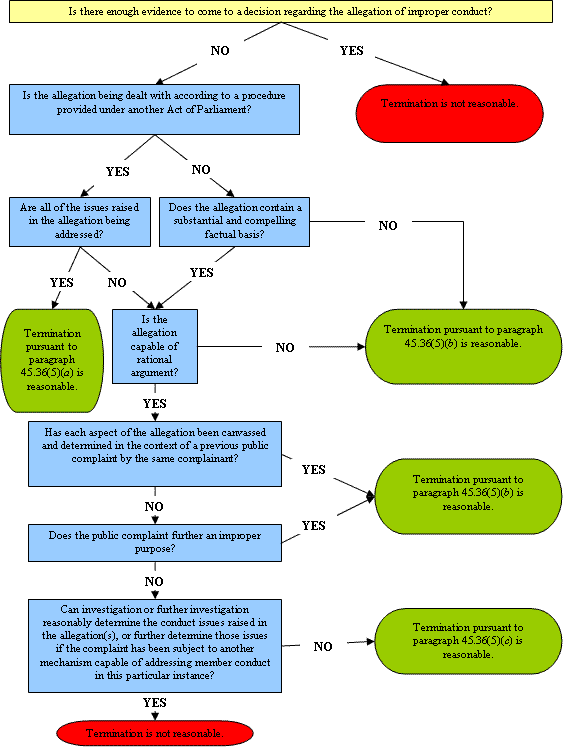
Review of the Record Report: 2007 – Force-Wide and Regional: Updated
Received Complaints
The Commission received 1,861 completed complaint dispositions from the RCMP relating to complaints lodged in 2007. The RCMP estimated that 2,500 complaints had been lodged in 2007; leaving over 600 complaints still outstanding from this time period.
The Pacific Region had the most complaints (834) representing 45% of the total, while the Northwest Region had 689 (38%), the Central Region had 62 (3%), and the Atlantic Region had 267 (14%).
Number of Complaints by Region
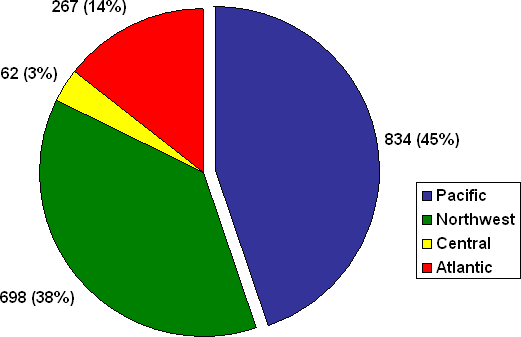
Of those complaints, 1,098 were lodged with the Commission (59%) while 750 were lodged with the RCMP (40%), and 13 were lodged with other organizations (0.7%).56
Number of Complaints Based on the Organizations it Was Lodged With
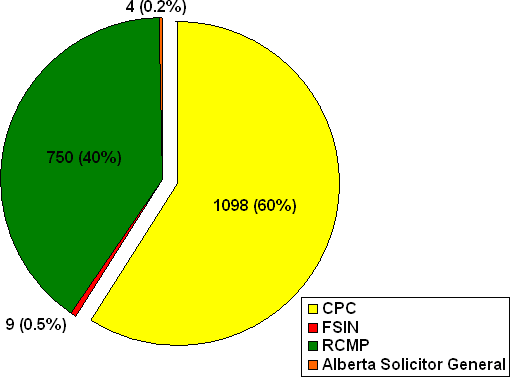
From a regional perspective, complainants in the Pacific Region appeared to favour lodging complaints with the Commission (68%). Only 32% within this region were lodged with the RCMP. Complaints originating from the Atlantic, Central, and Northwest Regions were split relatively evenly between those lodged with the Commission and the RCMP. For the Northwest Region, 52% of the complaints were lodged with the Commission, compared to 46% with the RCMP, and 2% with other organizations.57 In the Central Region, 52% were lodged with the Commission and 48% were lodged with the RCMP. For the Atlantic Region, 49% were lodged with the Commission and 51% were lodged with the RCMP.
Regional Breakdown – Number of Complaints Based on the Organization it Was Lodged With
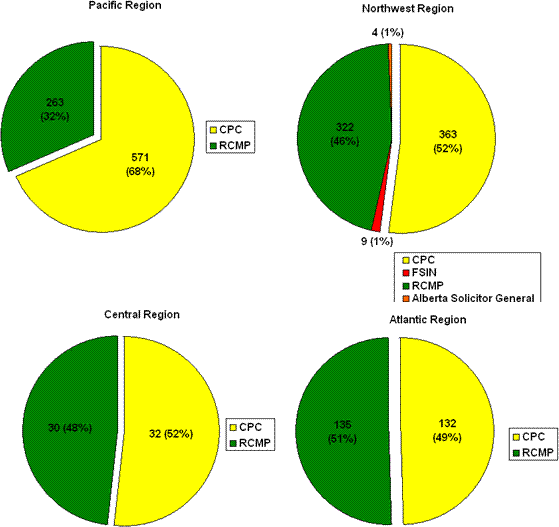
In 2007, the Commission received 102 of these complaints; the region most likely to have complaints against a whole detachment was the Atlantic Region, which represented 9% of their total complaints. A further eight (8) separate complaints were against the RCMP in general, three (3) of which originated from "A" Division.
The average number of members named in a complaint was 1.5. Given that most front-line policing within the RCMP is done by constables and corporals, it is not surprising that constables were represented in 71% of the total complaints. The rank of corporal was represented in 13% of the public complaints and sergeants were represented in 5% of the complaints.
Allegations
A total of 4,282 allegations were made against the RCMP and its members, which averaged approximately 2.3 allegations per complaint. The most common complaint allegations as identified by the RCMP were "Neglect of Duty" (27%), "Improper Attitude" (20%) and "Improper Use of Force" (15%).
Allegations Breakdown Force-Wide
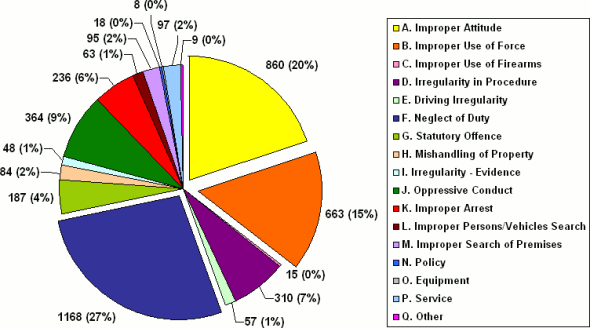
The three most common complaint allegations identified by the RCMP in the Pacific Region were "Neglect of Duty" (27%), "Improper Attitude" (21%) and "Improper Use of Force" (16%).
In the Northwest Region, the three most common complaint allegations were "Neglect of Duty" (26%), "Improper Attitude" (19%) and "Improper Use of Force" (17%).
In the Central Region the most common allegations were "Neglect of Duty" (31%), "Improper Attitude" (25%), and "Irregularity in Procedure" (16%).
In the Atlantic Region the three most common allegations were "Neglect of Duty" (31%), "Improper Attitude" (20%), and "Improper Use of Force" (11%).
The categorization of allegations can further be broken down into those complaints lodged with the Commission and those lodged with the RCMP. The allegations lodged with the Commission represent 61% of total allegations, those lodged with the RCMP represent 38%, and those lodged with other organizations represent 0.65%.58
Complaints involving allegations of "Irregularity – Evidence" (83%), "Improper Search of Premises (80%) and "Service" (74%) were most likely to be lodged with the Commission, followed closely by "Neglect of Duty" (73%). Conversely, complaints involving allegations of "Driving Irregularity" (68%) were more likely to be lodged with the RCMP.
Typically, complaint allegations such as "Improper Attitude", "Improper Use of Force", "Policy", and "Improper Persons/Vehicles Search" were evenly split between the Commission and the RCMP. Interestingly, 2% of the "Improper Use of Force" allegations were lodged with the FSIN for complaints lodged against members in Saskatchewan.
For every complaint disposition received, the Commission analyzed the reason and incident details in order to identify issues related to the nature of the complaint. The most common issues that were raised in the complaints were "Attitude" (15%), issues with "Arrest" (10%), "Criminal Investigation Quality" (10%), and "Vehicular Incidents" (7%).
Disposition of Complaints59
The RCMP can dispose of a complaint in one of four ways: a Final Report, a Notice of Direction (termination), Informal Resolution and accepting a withdrawal.
Number of Complaints by Disposition Type: Force-Wide
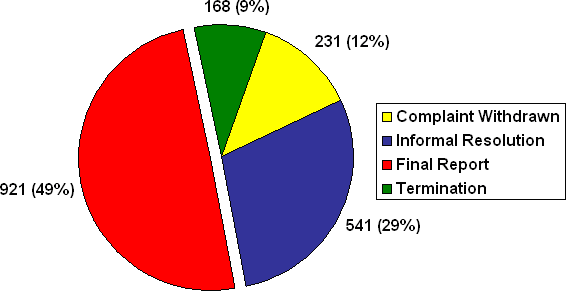
Regional Breakdown – Number of Complaints by Disposition Type
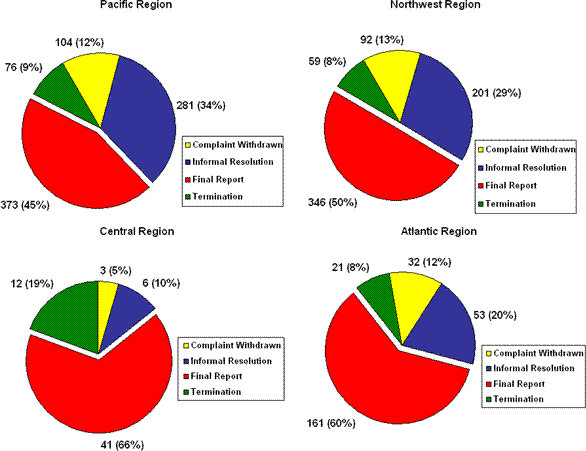
Investigation and Final Report
Of the complaint dispositions the Commission received, 921 were formally investigated and a Final Report was issued, representing 49% of the total dispositions. These reports made determinations on 2,623 allegations, with allegations of "Improper Use of Firearms", "Irregularity – Evidence", "Improper Use of Force" and "Oppressive Conduct" most likely to be disposed of in this manner.
However, when looking at the allegations that were investigated across the country, only 9% were found supported by the RCMP. For the allegation categories that were most likely to be disposed of through a Final Report by the RCMP, the RCMP did not support the allegation between 85% and 100% of the time. It is of note that among the allegations that are most likely to be unsupported by the RCMP were "Improper Use of Force" and "Statutory Offence" and that the RCMP did not support any allegations regarding "Policy" and "Irregularity – Evidence".
From a regional perspective, the Pacific Region issued a Final Report in 45% of the cases. These Final Reports made determinations on 1,070 allegations. The allegations most likely to be disposed of in this manner were "Oppressive Conduct", "Improper Use of Force", and "Irregularity in Procedure".
The Northwest Region issued a Final Report in 50% of the cases, which addressed 1,061 allegations. The allegations most likely to be disposed of in this manner were "Improper Use of Force" and "Irregularity – Evidence".
The Central Region issued a Final Report in 66% of the cases, well above the Force-wide average. These Final Reports made determinations on 72 allegations. The allegation most likely to result in an investigation and final report was "Neglect of Duty".
The Atlantic Region issued a Final Report in 60% of the cases, which dealt with 420 allegations. The allegations most likely to be disposed of in this manner were "Improper Arrest" and "Oppressive Conduct".
Informal Resolutions
Informal resolutions accounted for the second most common way to dispose of a complaint with 541 dispositions representing 29% of the 1,861 dispositions examined.60 In 2007, informal resolutions disposed of 866 allegations. Allegations relating to "Improper Attitude", "Driving Irregularity", and "Service" were most likely to be informally resolved. It is of note that 11% of these resolutions dealt with "Improper Use of Force" allegations (57 cases).
From a regional perspective the Pacific Region resolved 34% of their public complaints in this manner, which dealt with 473 allegations in total. Allegations most likely to result in an informal resolution were "Driving Irregularity" and "Service".
The Northwest Region informally resolved 29% of their public complaints, which dealt with 315 allegations in total. Allegations most likely to be resolved were "Improper Attitude" and "Service".
The Central Region informally resolved only 10% of their public complaints, well below the Force-wide average or the averages of other regions. Only five (5) total allegations were disposed of in this manner. The allegations that were informally resolved for this region were three (3) allegations of "Improper Attitude", one (1) allegation of "Driving Irregularity", and one (1) allegation of "Neglect of Duty".
The Atlantic Region informally resolved 20% of their public complaints in this manner, which dealt with 73 allegations in total. The allegation most likely to be resolved informally was "Improper Attitude".
Informal Resolution of Improper Use of Force Complaints
During the analysis of the documents related to the Review of the Record, the Commission noticed that 11% of the total informal resolutions dealt with allegations of improper use of force and that 12% of all use of force allegations resulted in an informal resolution (77 allegations). Further broken down, just over half (51%) of all allegations of improper use of force complaints that were informally resolved were disposed of in a manner that the Commission deemed inappropriate (39 allegations). Improper resolutions for use of force allegations were most likely to occur in "G" and "V" Divisions.
Withdrawals
Force-wide, complainants withdrew their public complaints in 12% of the cases, which represented 456 allegations. Allegations that were mostly likely to be withdrawn were "Mishandling of Property", "Improper Persons/Vehicles Search" and "Improper Search of Premises".
From a regional perspective, the Pacific Region disposed of 12% of its total public complaints in this manner, which addressed 232 total allegations. Allegations most likely to be withdrawn were "Improper Search of Premises", "Mishandling of Property", and "Improper Arrest".
The Northwest Region disposed of 13% of its total public complaints in this manner, which addressed 143 total allegations. Allegations most likely to be withdrawn were "Driving Irregularity", "Neglect of Duty", and "Mishandling of Property".
The Central Region disposed of only 5% of its total public complaints in this manner, which addressed three (3) total allegations. The allegations that were withdrawn were two (2) allegations of "Irregularity in Procedure" and one (1) allegation of "Neglect of Duty".
The Atlantic Region disposed of 12% of its total public complaints in this manner, which addressed 78 total allegations. Allegations most likely to be withdrawn were "Mishandling of Property" and "Improper Persons/Vehicles Search".
Terminations (Notice of Direction)
In 2007, 9% of all public complaints, representing 337 allegations, were terminated by the RCMP; the most common grounds for termination were paragraph (c), "investigation or further investigation is not necessary or reasonably practicable." The allegations that were most likely terminated were "Statutory Offence", "Service", and "Irregularity – Evidence".
Number of Terminated Complaints by Grounds Identified in subsection 45.36(5) of the RCMP Act
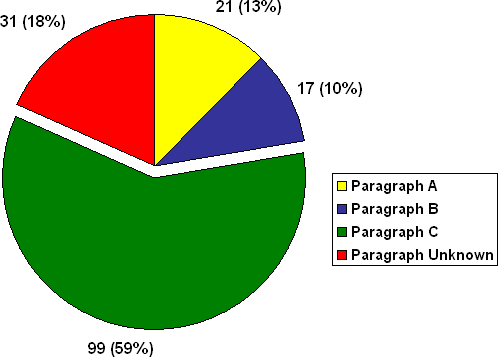
From a regional perspective, the Pacific Region disposed of 9% of its total public complaints through terminations, which addressed 159 total allegations. Allegations most likely to be the subject of a termination paragraph were "Statutory Offence" and "Service". The grounds for termination most likely to be identified in the Pacific Region were paragraph (c).
The Northwest Region disposed of 8% of its total public complaints through terminations, which addressed 129 allegations. Allegations most likely to be the subject of a termination paragraph were "Statutory Offence" and "Service". The grounds for termination most likely to be invoked in the Northwest Region were paragraph (c).
The Central Region disposed of 19% of its total public complaints through terminations, which addressed 16 allegations. This is far above the Force-wide average. The allegation most likely to be the subject of a termination paragraph was "Oppressive Conduct". Most often, the grounds for termination were not provided.
The Atlantic Region disposed of 8% of its total public complaints through terminations, which addressed 33 total allegations. Allegations most likely to be the subject of a termination paragraph were "Statutory Offence" and "Irregularity – Evidence". The grounds for termination most likely to be identified in the Atlantic Region were paragraph (c).
Service Standards: Processing Time61
In 2007 the RCMP took, on average, 150 days to issue a disposition once a complaint was lodged. The average number of days to issue a disposition was 156 for Commission-lodged complaints as opposed to 140 days for RCMP-lodged complaints. Interestingly, on average, 219 days elapsed before a complainant lodged a complaint after the incident of concern.
Complaint Timeline By Region
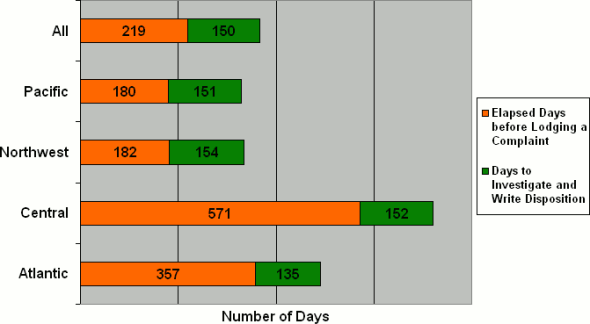
In the Pacific Region, on average, 180 days elapsed before a complainant lodged the original complaint. Once the complaint was received, it took, on average, 151 days for the divisions within this region to complete a disposition.
The average number of days that elapsed before a complainant in the Northwest Region lodged the original complaint was 182. Once the complaint was received, the divisions within this region took, on average, 154 days to complete a disposition.
In the Central Region, on average, 571 days elapsed before a complainant lodged the original complaint. It is suspected that the lengthy amount of time to lodge a complaint may be linked to complainants whose issue(s) with RCMP conduct may span years or may be linked to some historical event. Once the complaint was received it took, on average, 152 days for divisions within this region to complete a disposition.
The average number of days that elapsed before a complainant in the Atlantic Region lodged the original complaint was 357 days. Once the complaint was received the divisions within this region took, on average, 135 days to complete a disposition.
After looking at these timelines in general, the Commission attempted to determine if there was a difference with respect to these averages between Commission-lodged complaints and RCMP-lodged complaints. As represented by the orange bar in Figure 26, there can be a considerable amount of time that elapses between the incident date and the date the complainant lodges the original complaint. On average, complainants waited 270 days after the incident took place before lodging the original complaint directly with the Commission, while complaints lodged with the RCMP averaged only 147 days after the incident.
The average number of days62 for the Commission to receive the complaint disposition from the RCMP as a whole was 113 days for Commission-lodged complaints as opposed to the 127 days it took for RCMP-lodged complaints.
To that end, the average number of days for the Commission to receive the complaint disposition from:
- the Pacific Region, 124 days for Commission-lodged complaints as opposed to 98 days for RCMP-lodged complaints;
- the Northwest Region, 118 days for Commission-lodged complaints as opposed to 175 days for RCMP-lodged complaints;
- the Central Region, 66 days for Commission-lodged complaints as opposed to 61 days for RCMP-lodged complaints; and
- the Atlantic Region, 62 days for Commission-lodged complaints as opposed to 84 days for RCMP-lodged complaints.
Complaint Timeline – Comparison Based on Where the Complaint Was Lodged
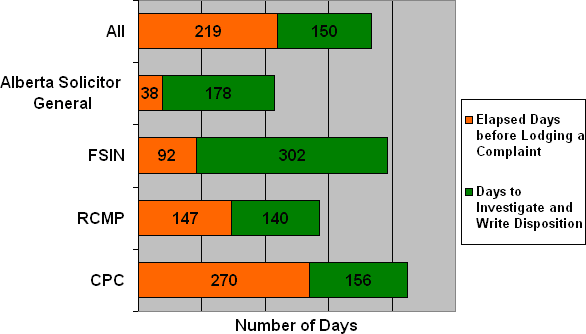
1 Please see Appendix D for an overview of the RCMP public complaint process.
2 Please see Appendix F for a chart of the yearly comparisons.
3 The RCMP Act does not require a response. Notwithstanding that, some divisions did respond directly to the Commission.
4 A completed public complaint record was defined as the record of all complaints received by the RCMP under Part VII of the RCMP Act and included RCMP Form 4110 capturing informal resolutions and withdrawals, Form 4110 and a Notice of Direction as defined by subsection 45.36(6) of the Act, and Form 4110 and the Final Report as defined by section 45.4 of the Act.
5 This number represents the number of complaints that have been lodged in 2008; it does not represent the number of complaints that have been completed.
6 Four (4) complaints were lodged with the Federation of Saskatchewan Indian Nations and three (3) were lodged with the Alberta Solicitor General.
7 The divisions and associated province or territory is as follows: "A" Division: National Capital Region; "B" Division: Newfoundland and Labrador; "C" Division: Quebec; "D" Division: Manitoba; "E" Division: British Columbia; "F" Division: Saskatchewan; "G" Division: Northwest Territories; "H" Division: Nova Scotia; "J" Division: New Brunswick; "K" Division: Alberta; "L" Division: Prince Edward Island; "M" Division: Yukon; "O" Division: Ontario; "V" Division: Nunavut.
8 For administrative purposes the RCMP is divided into four regions, which are then divided into divisions and further divided into detachments. The Review of the Record Project captures and tracks data Force-wide, regionally, divisionally, and at the detachment level.
9 A Notice of Direction is also referred to as a termination and captures the RCMP termination of an investigation into a complaint.
10 These averages do not mean that it took the RCMP a particular amount of time to provide the complainant with the disposition; the timelines are specific to the RCMP providing the Commission with a copy of the dispositions.
11 While the reasons for this has not been fully examined, some preliminary analysis of the data suggests that complainants wait to lodge complaints because: 1) the complainant may not have immediate access to the public complaint system; 2) the complaint may be historical in that an incident occurred many years (in some cases decades) before a formal complaint is lodged; and 3) alternate ways of resolving the complaint may have been attempted before a formal complaint was lodged.
12 In the Commission's experience, in 2008, this was the exception rather than the rule.
13 Excerpts of which have been reproduced in this report for the purposes of situating the statistics associated with terminating complaints.
14 The Commission has requested a copy of all public complaint records, pursuant to paragraph 45.47(b) of the RCMP Act. A completed public complaint record was defined as the record of all complaints received by the RCMP under Part VII of the RCMP Act and included RCMP Form 4110 capturing informal resolutions and withdrawals, Form 4110 and a Notice of Direction as defined by subsection 45.36(6) of the Act, and Form 4110 and the Final Report as defined by section 45.4 of the Act.
15 It was decided to give the RCMP six (6) additional months to provide the Commission with the complaint disposition for complaints lodged in 2008.
16 As of December 7th, 2009, the Commission has received 4,572 completed complaint dispositions since the begining of the project.
17 This number represents the number of complaints that have been lodged in 2008; it does not represent the number of complaints that have been completed.
18 The Pacific Region includes British Columbia and the Yukon.
19 The Northwest Region includes Nunavut, Manitoba, Saskatchewan, Northwest Territories and Alberta.
20 The Central Region includes Quebec and Ontario.
21 The Atlantic Region includes Newfoundland and Labrador, Nova Scotia, New Brunswick and Prince Edward Island.
22 The Commission also captured completed complaints that were lodged with the FSIN and the Alberta Solicitor General; both have been included in the "Other" category. Four (4) complaints were lodged initially with the FSIN accounting for 0.2% of the total complaints, while three (3) completed complaints were lodged with the Alberta Solicitor General, accounting for 0.2% of the total.
23 Please see Appendix F for a chart of the yearly comparisons
24 0.43% of complaints were lodged with the Alberta Solicitor General and 0.58% were lodged with the FSIN.
25 The Commission did not receive any complaints that were lodged with the Alberta Solicitor General in time for inclusion in the 2007 report; however, unless clearly indicated that the complaint was lodged with the Alberta Solicitor General the Commission would have no way to verify how many complaints were lodged with this provincial body and therefore would be unable to predict how many dispositions should be provided to the Commission by the RCMP.
26 A list of complaint allegation types and a brief description of each can be found in Appendix C. However, it should be noted that the Commission has concerns with the way in which the RCMP classifies its complaints, as there have been instances of misclassification. For example, allegations that would more appropriately be classified as "Improper Use of Force" are officially classified as "Neglect of Duty". This has the effect of skewing the actual types of complaints and hiding more serious complaints in less serious categories.
27 Additionally, in 2008, seven (7) allegations were lodged with the Alberta Solicitor General (0.16%) and another seven (7) were lodged with the FSIN (0.16%).
28 46 issue categories were created, and descriptions can be found in Appendix B of this report.
29 The issue of "attitude" was distinguished from "abusive language", which accounted for 2.10% of the issues.
30 Within the Disposition of Complaints section, there is a further breakdown to identify in what manner allegations categories have been disposed. For each allegation category, the number of allegations disposed of through each disposition type was divided by the total number of those allegations. These numbers were then compared from one allegation category to the next with the goal of determining which allegation was most likely to be disposed of by a certain disposition type. Therefore, an allegation category was more likely to be disposed of in a certain manner if the percentage disposed of in this way was significantly higher than that of other allegations categories. "Most likely" does not mean most common.
31 These types of reports are referred to as "Final Reports" and in this instance only refer to the RCMP's disposition of the complaint after a public complaint investigation is concluded.
32 It should be noted that the total number of allegations identified as being dealt with and the total number of allegations where a determination of supported or unsupported was made in a Final Report may differ, as there are occasions when the RCMP has been unable to make a determination due to lack of evidence or the allegation was not separately addressed.
33 This table shows a frequency distribution of all allegations disposed of in this manner. It shows how common each allegation category was within the disposition type, not how likely it was to be disposed of in this manner.
34 Form 4110 is RCMP's Public Complaint Report.
35 In some cases it was impossible to determine if the member who was the subject of the complaint was aware of either the complaint or the disposition.
36 The percentages relating to informal resolutions and withdrawal of complaints can be deceiving. After reviewing the complete complaint records that have been provided to the Commission, the RCMP occasionally categorizes a withdrawal as an informal resolution and vice versa. Therefore, it is difficult to determine exactly how many informal resolutions and withdrawals the RCMP completes each year, as at times there is often a misclassification.
37 This table shows a frequency distribution of all allegations disposed of in this manner. It shows how common each allegation category was within the disposition type, not how likely it was to be disposed of in this manner.
38 The Commission followed up with the RCMP with respect to this complaint disposition. To date the RCMP has not responded to our request for further information or to our suggestion that an investigation may be warranted.
39 This table shows a frequency distribution of all allegations disposed of in this manner. It shows how common each allegation category was within the disposition type, not how likely it was to be disposed of in this manner.
40 For a more fulsome explanation of the Commission's stance on the application of the RCMP Act to terminate public complaints as well as the criteria upon which the Commission reviews the reasonableness of these terminations, please contact the Commission directly or visit our website to download the position paper.
41 This table shows a frequency distribution of all allegations disposed of in this manner. It shows how common each allegation category was within the disposition type, not how likely it was to be disposed of in this manner.
42 Paragraph 45.36(5)(b) of the RCMP Act has been used to terminate the investigation into a public complaint in situations where chronic or multiple-complaint complainants continue to submit virtually identical complaints. In such situations, the RCMP must determine that the complainant is not providing sufficient grounds to embark on a new public complaint investigation, and there should be no indication that such an investigation would achieve any useful purpose.
43 Total complainants, n = 1,695
44 The Commission notes the value of early intervention and a coordinated response to managing police officers who are displaying conduct-related issues. The importance of this is borne out in reports such as "Project Odin: Identifying and Managing High Risk Officers in the NSW Police Force" authored by the Police Integrity Commission in Australia, the "Twenty-Seventh Semiannual Report, Los Angeles County Sheriff's Department", report authored by Merrick Bobb and the Police Assessment Resource Centre as well as hundreds of reports on police performance and the importance of instituting early warning tracking systems into law enforcement oversight mechanisms.
45 Total members, n = 2,256
46 By identifying the complaint date and comparing it to the disposition date, the Commission was able to determine how many days it took the RCMP to issue a disposition for each complaint. Similarly, by comparing the complaint date to the date the incident occurred, a timeline can be established to determine how many days elapsed before a complainant lodged a public complaint against the RCMP.
47 While the reasons for this has not been fully examined, some preliminary analysis of the data suggests that complainants wait to lodge complaints because:
- 1) the complainant may not have immediate access to the public complaint system;
- 2) the complaint may be historical in that an incident occurred many years (in some cases decades) before a formal complaint is lodged; and
- 3) alternate ways of resolving the complaint may have been attempted before a formal complaint was lodged.
48 These averages do not necessarily mean that it took the RCMP a particular amount of time to provide the complainant with the disposition; the timelines are specific to the RCMP providing the Commission with a copy of the dispositions. The averages are calculated using the date of the disposition and the date the Commission received the documents.
49 While this may seem an innocuous oversight, the effect that an incorrect reference to the Commission can have on the RCMP public complaint system is not. Without a proper address, and absent the knowledge that the complainant has a right to appeal the RCMP disposition of their complaint, the role of the Commission is undermined and the complainant is not fully apprised of their rights under the RCMP Act, which in turn denies them full access to the RCMP public complaint process.
50 As of April 1, 2009, the Commission will henceforth be notified promptly of all new RCMP-lodged complaints, and this information will, in the future, be included in the list and be reported on in forthcoming Review of the Record reports.
51 This also includes complaints that were lodged before January 1, 2007.
52 In order to be methodologically consistent and to enable comparisons between the statistics from 2007 and 2008 the Commission was unable to extend the deadline specific to the Quantitative Analysis section of the report.
53 Although some serious allegations can at times be considered less serious once all details are examined, this classification can be mitigated in the first instance by a better description of allegations as well as a more fulsome explanation of the final resolution.
54 In the Commission's experience, in 2008, this was the exception rather than the rule.
55 The list of issues incorporates words or phrases most commonly used by complainants and the RCMP to describe the situation and context of the complaints.
56 Nine (9) complaints were lodged with the FSIN (0.5%), and four (4) were lodged with the Alberta Solicitor General (0.2%).
57 1.29% of complaints were lodged with the FSIN, and 0.57% with the Alberta Solicitor General.
58 Allegations lodged with the FSIN represent 0.47% of total allegations, and those lodged with the Alberta Solicitor General represent 0.19%.
59 Within the Disposition of Complaints section, there is a further breakdown to identify in what manner allegations categories have been disposed. For each allegation category, the number of allegations disposed of through each disposition type was divided by the total number of those allegations. These numbers were then compared from one allegation category to the next with the goal of determining which allegation was most likely to be disposed of by a certain disposition type. Therefore, an allegation category was more likely to be disposed of in a certain manner if the percentage disposed of in this way was significantly higher than that of other allegations categories. "Most likely" does not mean most common.
60 The percentages relating to informal resolutions and withdrawal of complaints can be deceiving. After reviewing the complete complaint records that have been provided to the Commission, the RCMP occasionally categorizes a withdrawal as an informal resolution and vice versa. Therefore, it is difficult to determine exactly how many informal resolutions and withdrawals the RCMP completes each year, as there is often a misclassification.
61 By identifying the complaint date and comparing it to the disposition date, the Commission was able to determine how many days it took the RCMP to issue a disposition for each complaint. Similarly, by comparing the complaint date to the date the incident occurred, a timeline can be established to determine how many days elapsed before a complainant lodged a public complaint against the RCMP.
62 These averages do not necessarily mean that it took the RCMP a particular amount of time to provide the complainant with the disposition; the timelines are specific to the RCMP providing the Commission with a copy of the dispositions. The averages are calculated using the date of the disposition and the date the Commission received the documents.
- Date modified:

